Document Outline
- FEATURES
- APPLICATIONS
- FUNCTIONAL BLOCK DIAGRAM
- GENERAL DESCRIPTION
- Ģˇ
- Ģˇ
- Ģˇ
- Ģˇ
- Ģˇ
- Ģˇ
- Ģˇ
- Ģˇ
- Ģˇ
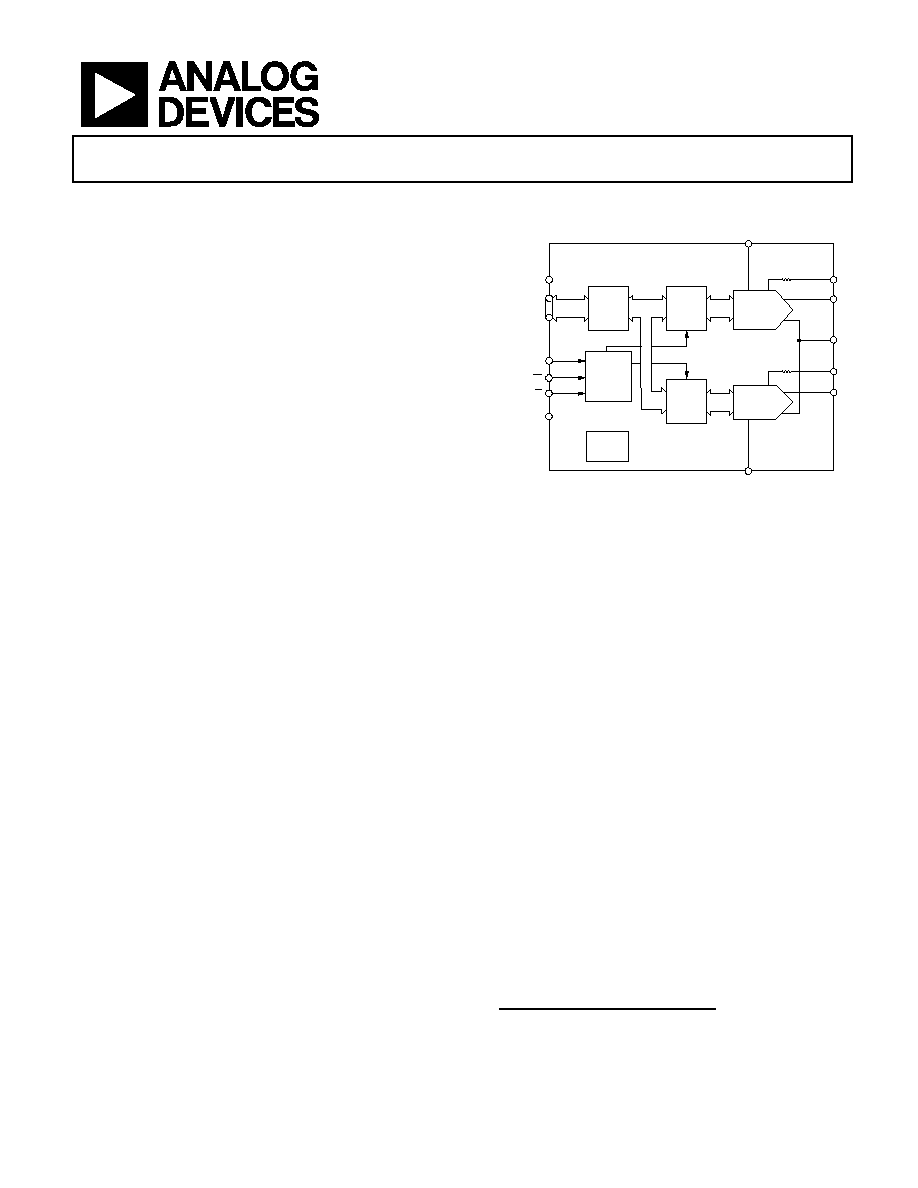
Dual 8-,10-,12-Bit, High Bandwidth
Multiplying DACs with Parallel Interface
AD5428/AD5440/AD5447
Rev. 0
Information furnished by Analog Devices is believed to be accurate and reliable.
However, no responsibility is assumed by Analog Devices for its use, nor for any
infringements of patents or other rights of third parties that may result from its use.
Specifications subject to change without notice. No license is granted by implication
or otherwise under any patent or patent rights of Analog Devices. Trademarks and
registered trademarks are the property of their respective owners.
One Technology Way, P.O. Box 9106, Norwood, MA 02062-9106, U.S.A.
Tel: 781.329.4700
www.analog.com
Fax: 781.326.8703
© 2004 Analog Devices, Inc. All rights reserved.
FEATURES
10 MHz multiplying bandwidth
Fast parallel interface (58 MSPS write cycle)
AD7528 upgrade (AD5428)
AD7547 upgrade (AD5447)
2.5 V to 5.5 V supply operation
Ī10 V reference input
20- and 24-lead TSSOP packages
Dual 8-, 10-, and 12-bit current output DACs
Guaranteed monotonic
4-quadrant multiplication
Power-on reset
Readback function
0.5 ĶA typical current consumption
FUNCTIONAL BLOCK DIAGRAM
04462-
0-
001
CONTROL
LOGIC
INPUT
BUFFER
DATA
INPUTS
I
OUT
A
DB0
DAC A/B
CS
R/W
DGND
DB7
DB9
DB11
I
OUT
B
AGND
AD5428/AD5440/AD5447
LATCH
LATCH
8-/10-/12-BIT
R-2R DAC A
8-/10-/12-BIT
R-2R DAC B
POWER-ON
RESET
V
DD
V
REF
A
V
REF
B
R
FB
A
R
FB
B
R
R
Figure 1. AD5428/AD5440/AD5447
APPLICATIONS
Portable battery-powered applications
Waveform generators
Analog processing
Instrumentation applications
Programmable amplifiers and attenuators
Digitally controlled calibration
Programmable filters and oscillators
Composite video
Ultrasound
Gain, offset, and voltage trimming
GENERAL DESCRIPTION
The AD5428/AD5440/AD5447
1
are dual CMOS 8-, 10-, and
12-bit current output digital-to-analog converters (DACs),
respectively.
These devices operate from a 2.5 V to 5.5 V power supply,
making them suited to battery-powered and other applications.
The DACs utilize data readback, allowing the user to read the
contents of the DAC register via the DB pins. On power-up, the
internal register and latches are filled with zeros and the DAC
outputs are at zero scale.
As a result of manufacture on a CMOS submicron process, they
offer excellent 4-quadrant multiplication characteristics, with
large signal multiplying bandwidths of up to 10 MHz.
The applied external reference input voltage (V
REF)
determines
the full-scale output current. An integrated feedback resistor
(R
FB
) provides temperature tracking and full-scale voltage
output when combined with an external I-to-V precision
amplifier.
The AD5428 is available in a small 20-lead TSSOP package,
while the AD5440/AD5447 DACs are available in small 24-lead
TSSOP packages.
1
US Patent Number 5,689,257.

AD5428/AD5440/AD5447
Rev. 0 | Page 2 of 28
TABLE OF CONTENTS
Specifications..................................................................................... 3
Timing Characteristics..................................................................... 5
Absolute Maximum Ratings............................................................ 6
ESD Caution.................................................................................. 6
Pin Configurations and Function Descriptions ........................... 7
Terminology .................................................................................... 10
Typical Performance Characteristics ........................................... 11
General Description................................................................... 16
Circuit Operation ....................................................................... 16
Single-Supply Applications........................................................ 18
Positive Output Voltage ............................................................. 19
Adding Gain................................................................................ 19
Used as a Divider or Programmable Gain Element............... 19
Reference Selection .................................................................... 20
Amplifier Selection .................................................................... 20
Parallel Interface......................................................................... 20
Microprocessor Interfacing....................................................... 20
PCB Layout and Power Supply Decoupling ........................... 21
Evaluation Board for the DACs................................................ 21
Power Supplies for the Evaluation board ................................ 21
Bill of Materials............................................................................... 25
Overview of AD54xx Devices....................................................... 26
Outline Dimensions ....................................................................... 27
Ordering Guide .......................................................................... 28
REVISION HISTORY
7/04--Revision 0: Initial Version

AD5428/AD5440/AD5447
Rev. 0 | Page 3 of 28
SPECIFICATIONS
Temperature range for Y version is ≠40įC to +125įC.
V
DD
= 2.5 V to 5.5 V, V
REF
A = V
REF
B = +10 V, AGND = 0 V. All specifications T
MIN
to T
MAX
, unless otherwise noted. DC performance
measured with OP1177, AC performance with AD8038, unless otherwise noted.
Table 1.
Parameter
Min
Typ
Max
Unit
Conditions
STATIC PERFORMANCE
AD5428
Resolution
8
Bits
Relative Accuracy
Ī0.25
LSB
Differential Nonlinearity
Ī1
LSB
Guaranteed monotonic
AD5440
Resolution
10
Bits
Relative Accuracy
Ī0.5
LSB
Differential Nonlinearity
Ī1
LSB
Guaranteed monotonic
AD5447
Resolution
12
Bits
Relative Accuracy
Ī1
LSB
Differential Nonlinearity
≠1/+2
LSB
Guaranteed monotonic
Gain Error
Ī10
m V
Gain Error Temp CoefficientT
1
Ī5
ppm FSR/įC
Output Leakage Current
Ī10
nA
Data = 0000
H
, T
A
= 25įC.
Ī25
nA
Data = 0000
H.
REFERENCE INPUT
1
Reference Input Range
Ī10
V
V
REF
A, V
REF
B Input Resistance
8
10
12
k
Input resistance TC = ≠50 ppm/įC
V
REF
A to V
REF
B Input
Resistance Mismatch
1.6
2.5
%
Typ = 25įC, max = 125įC
R
FB
A,R
FB
B Input Resistance
8
10
12
k
Input resistance TC = ≠50 ppm/įC
Input Capacitance
Code 0
3
6
pF
Code 4095
5
8
pF
DIGITAL INPUTS/OUTPUT
1
Input High Voltage, V
IH
1.7
V
V
DD
= 2.5 V to 5.5 V
Input Low Voltage, V
IL
0.8
V
V
DD
= 2.7 V to 5.5 V
0.7
V
V
DD
= 2.5 V to 2.7 V
Input Leakage Current, I
IL
2
ĶA
Input Capacitance
4
10
pF
V
DD
= 4.5 V to 5.5 V
Output Low Voltage, V
OL
0.4
V
I
SINK
= 200 ĶA
Output High Voltage, V
OH
V
DD
-1
V
I
SOURCE
= 200 ĶA
V
DD
= 2.5 V to 3.6 V
Output Low Voltage, V
OL
0.4
V
I
SINK
= 200 ĶA
Output High Voltage, V
OH
V
DD
- 0.5
V
I
SOURCE
= 200 ĶA
DYNAMIC PERFORMANCE
1
Reference Multiplying BW
10
MHz
V
REF
= Ī3.5 V, DAC loaded all 1s
Output Voltage Settling Time
V
REF
= Ī10 V, R
LOAD
= 100 , C
LOAD
= 15 pF
DAC
latch
alternatively loaded with 0s and 1s
AD5428
30
60
ns
Measured to Ī16 mV of FS
AD5440
35
70
ns
Measured to Ī4 mV of FS
AD5447
80
120
ns
Measured to Ī1 mV of FS
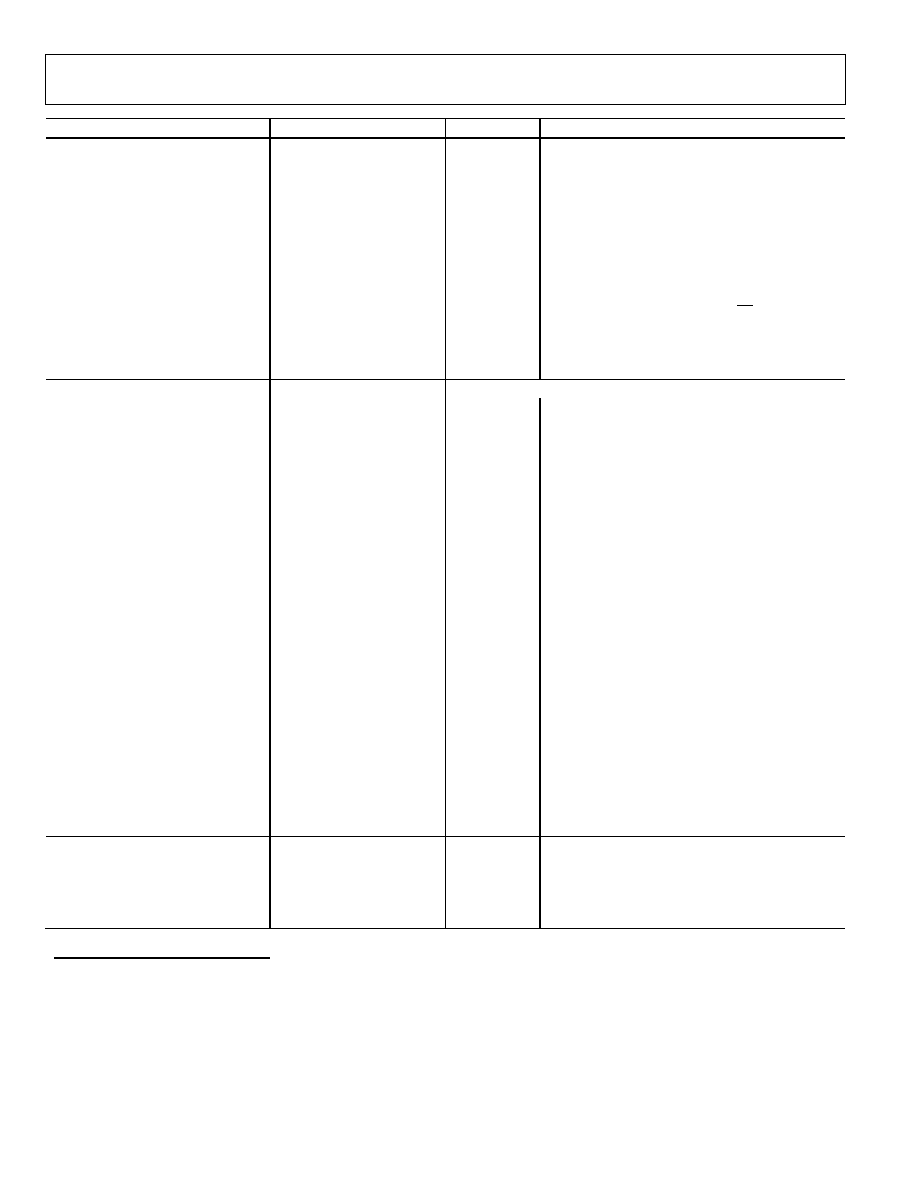
AD5428/AD5440/AD5447
Rev. 0 | Page 4 of 28
Parameter
Min
Typ
Max
Unit
Conditions
Digital Delay
20
40
ns
Interface delay time
10% to 90% Settling Time
15
30
Ns
Rise and fall time, V
REF
= 10 V, R
LOAD
= 100
Digital-to-Analog Glitch Impulse
2
nV
-s
1 LSB change around major carry, V
REF
= 0 V
Multiplying Feedthrough Error
≠75
dB
DAC latches loaded with all 0s. Reference = 10 kHz
Output Capacitance
I
OUT
2
22
25
pF
DAC latches loaded with all 0s
10
12
pF
DAC latches loaded with all 1s
I
OUT
1
12
17
pF
DAC latches loaded with all 0s
25
30
pF
DAC latches loaded with all 1s
Digital Feedthrough
1
nV
-s
Feedthrough to DAC output with CS high and
alternate loading of all 0s and all 1s
Total Harmonic Distortion
-81
dB
V
REF
= 3.5 V p-p, all 1s loaded, f = 1 kHz
Output Noise Spectral Density
25
nV/Hz
@ 1 kHz
SFDR Performance (Wideband)
AD5447, 65 k codes, V
REF
= 3.5 V
Clock = 10 MHz
500 kHz f
OUT
55
dB
100 kHz f
OUT
63
dB
50 kHz f
OUT
65
dB
Clock = 25 MHz
500 kHz f
OUT
50
dB
100 kHz f
OUT
60
dB
50 kHz f
OUT
62
dB
SFDR Performance (Narrow Band)
AD5447, 65 k codes, V
REF
= 3.5 V
Clock = 10 MHz
500 kHz f
OUT
73
dB
100 kHz f
OUT
80
dB
50k Hz f
OUT
87
dB
Clock = 25 MHz
500 kHz f
OUT
70
dB
100 kHz f
OUT
75
dB
50 kHz f
OUT
80
dB
Intermodulation Distortion
AD5447, 65 k codes, V
REF
= 3.5 V
Clock = 10 MHz
f
1
= 400 kHz, f
2
= 500 kHz
65
dB
f
1
= 40 kHz, f
2
= 50 kHz
72
dB
Clock = 25 MHz
f
1
= 400 kHz, f
2
= 500 kHz
51
dB
f
1
= 40 kHz, f
2
= 50 kHz
65
dB
POWER REQUIREMENTS
Power Supply Range
2.5
5.5
V
I
DD
0.6
ĶA
T
A
= 25įC. Logic inputs = 0 V or V
DD
0.5
10
ĶA
Logic inputs = 0 V or V
DD
Power Supply Sensitivity
1
0.001
%/%
V
DD
= Ī5%
1
Guaranteed by design, not subject to production test.

AD5428/AD5440/AD5447
Rev. 0 | Page 5 of 28
TIMING CHARACTERISTICS
Temperature range for Y version is ≠40įC to +125įC. Guaranteed by design and characterization, not subject to production test.
All input signals are specified with tr = tf = 1 ns (10% to 90% of V
DD
) and timed from a voltage level of (V
IL
+ V
IH
)/2. Digital output
timing measured with load circuit in Figure 3. V
DD
= 2.5 V to 5.5 V, V
REF
= 10 V, I
OUT
2 = 0 V. All specifications T
MIN
to T
MAX
, unless
otherwise noted.
Table 2.
Parameter
Limit at T
MIN
, T
MAX
Unit
Conditions/Comments
Write Mode
t
1
0
ns min
R/W to CS setup time
t
2
0
ns min
R/W to CS hold time
t
3
10
ns min
CS low time
t
4
10
ns min
Address setup time
t
5
0
ns min
Address hold time
t
6
6
ns min
Data setup time
t
7
0
ns min
Data hold time
t
8
5
ns min
R/W high to CS low
t
9
7
ns min
CS min high time
Data Readback Mode
t
10
0
ns typ
Address setup time
t
11
0
ns typ
Address hold time
t
12
5
ns typ
Data access time
25
ns max
t
13
5
ns typ
Bus relinquish time
10
ns max
04462-0-002
DATA VALID
DATA VALID
DATA
DACA/DACB
CS
R/W
t
1
t
3
t
4
t
10
t
5
t
8
t
7
t
11
t
9
t
2
t
8
t
2
t
12
t
13
Figure 2. Timing Diagram
04462-0-003
TO OUTPUT
PIN
V
OH (MIN)
+ V
OL (MAX)
200
Ķ
A
I
OH
200
Ķ
A
I
OL
2
C
L
50pF
Figure 3. Load Circuit for Data Output Timing Specifications
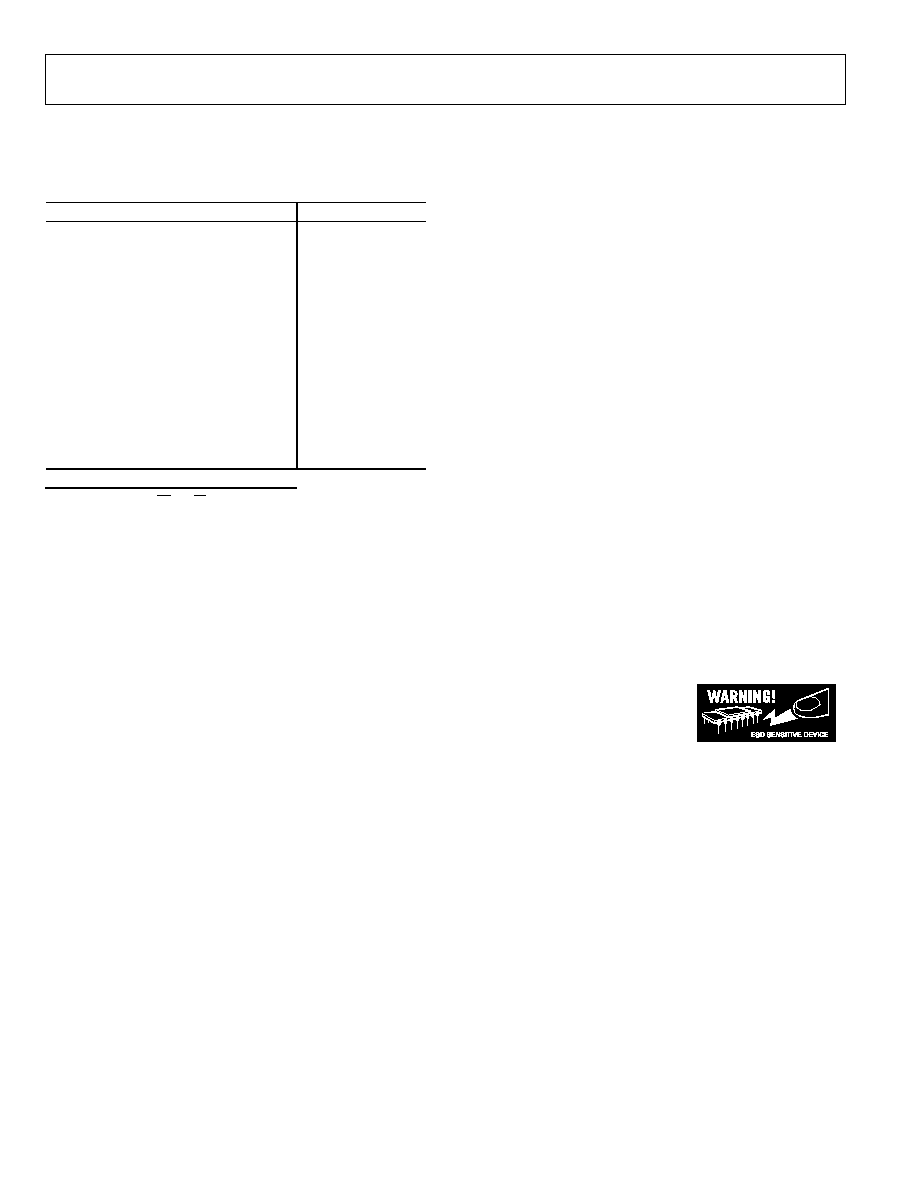
AD5428/AD5440/AD5447
Rev. 0 | Page 6 of 28
ABSOLUTE MAXIMUM RATINGS
T
A
= 25įC, unless otherwise noted.
Table 3.
Parameter Rating
V
DD
to GND
≠0.3 V to +7 V
V
REF
A, V
REF
B, R
FB
A, R
FB
B to DGND
≠12 V to +12 V
I
OUT
1, I
OUT
2 to DGND
≠0.3 V to +7 V
Logic Inputs and Output
1
≠0.3 V to V
DD
+ 0.3 V
Operating Temperature Range
Automotive (Y Version)
≠40įC to +125įC
Storage Temperature Range
≠65įC to +150įC
Junction Temperature
150įC
20-lead TSSOP
JA
Thermal Impedance
143įC/W
24-lead TSSOP
JA
Thermal Impedance
128įC/W
Lead Temperature, Soldering
(10 seconds)
300įC
IR Reflow, Peak Temperature
(< 20 seconds)
235įC
1
Overvoltages at DBx, CS, and W/R are clamped by internal diodes. Current
should be limited to the maximum ratings given.
Stresses above those listed in Absolute Maximum Ratings may
cause permanent damage to the device. This is a stress rating
only; functional operation of the device at these or any other
conditions above those listed in the operational sections of this
specification is not implied. Exposure to absolute maximum
rating conditions for extended periods may affect device
reliability. Only one absolute maximum rating may be applied
at any one time.
ESD CAUTION
ESD (electrostatic discharge) sensitive device. Electrostatic charges as high as 4000 V readily accumulate on
the human body and test equipment and can discharge without detection. Although this product features
proprietary ESD protection circuitry, permanent damage may occur on devices subjected to high energy
electrostatic discharges. Therefore, proper ESD precautions are recommended to avoid performance
degradation or loss of functionality.
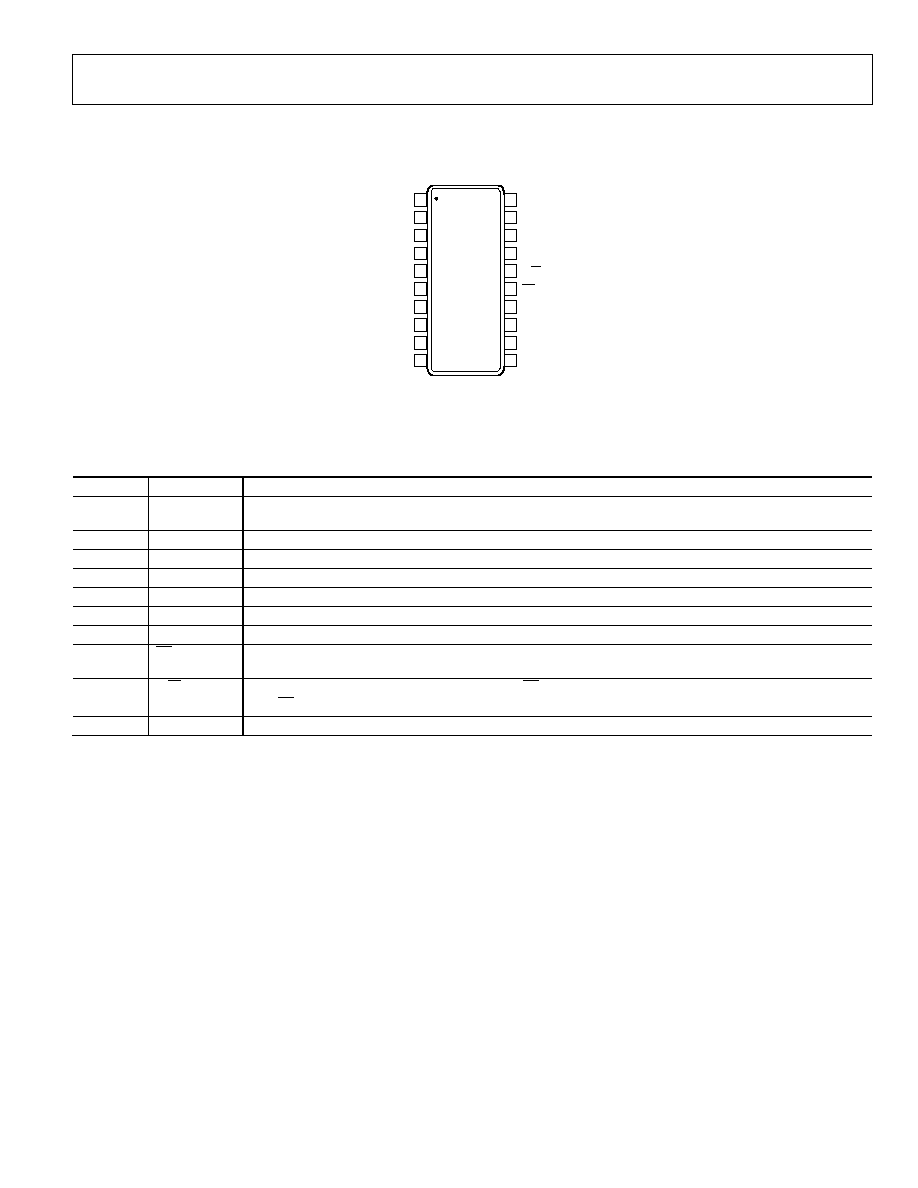
AD5428/AD5440/AD5447
Rev. 0 | Page 7 of 28
PIN CONFIGURATIONS AND FUNCTION DESCRIPTIONS
04462-0-004
R/W
CS
1
2
3
4
5
6
7
8
9
10
20
19
18
17
16
15
14
13
12
11
I
OUT
A
R
FB
A
V
REF
A
DB7
DAC A/B
DGND
AGND
R
FB
B
V
REF
B
V
DD
DB0 (LSB)
DB4
DB5
DB6
DB3
DB2
DB1
I
OUT
B
AD5428
TOP VIEW
(Not to Scale)
Figure 4. Pin Configuration 20-Lead TSSOP (RU-20)
Table 4. AD5428 Pin Function Descriptions
Pin No.
Mnemonic
Function
1
AGND
DAC Ground Pin. Typically, this pin should be tied to the analog ground of the system, but may be biased to
achieve single-supply operation.
2, 20
I
OUT
A, I
OUT
B
DAC Current Outputs.
3, 19
R
FB
A, R
FB
B
DAC Feedback Resistor Pins. Establish voltage output for the DAC by connecting to external amplifier output.
4, 18
V
REF
A, V
REF
B
DAC Reference Voltage Input Terminals.
5
DGND
Digital Ground Pin.
6
DAC A/B
Selects DAC A or B. Low selects DAC A, or, alternatively, high selects DAC B.
7 to14
DB7 to DB0
Parallel Data Bits 7 through 0.
15
CS
Chip Select Input. Active low. Used in conjunction with R/W to load parallel data to the input latch or to read
data from the DAC register.
16
R/W
Read/Write. When low, used in conjunction with CS to load parallel data. When high, used in conjunction
with CS to read back contents of the DAC register.
17
V
DD
Positive Power Supply Input. This part can be operated from a supply of 2.5 V to 5.5 V.

AD5428/AD5440/AD5447
Rev. 0 | Page 8 of 28
04462-0-005
R/W
CS
1
2
3
4
5
6
7
8
9
10
20
21
22
23
24
19
18
17
16
15
14
13
12
11
I
OUT
A
R
FB
A
V
REF
A
DB9
DAC A/B
DGND
AGND
R
FB
B
V
REF
B
V
DD
NC
DB8
DB7
DB4
DB5
DB6
NC
DB0 (LSB)
DB3
DB2
DB1
I
OUT
B
AD5440
TOP VIEW
(Not to Scale)
NC = NO CONNECT
Figure 5. Pin Configuration 24-Lead TSSOP (RU-24)
Table 5. AD5440 Pin Function Descriptions
Pin No.
Mnemonic
Function
1
AGND
DAC Ground pin. Typically, this pin should be tied to the analog ground of the system, but may be biased to
achieve single-supply operation.
2, 24
I
OUT
A, I
OUT
B
DAC Current Outputs.
3, 23
R
FB
A, R
FB
B
DAC Feedback Resistor Pins. Establish voltage output for the DAC by connecting to external amplifier output.
4, 22
V
REF
A, V
REF
B
DAC Reference Voltage Input Terminals.
5
DGND
Digital Ground pPin.
6
DAC A/B
Selects DAC A or B. Low selects DAC A, or, alternatively, high selects DAC B.
7 to16
DB9 to DB0
Parallel Data Bits 9 through 0.
19
CS
Chip Select Input. Active low. Used in conjunction with R/W to load parallel data to the input latch or to read
data from the DAC register.
20
R/W
Read/Write. When low, used in conjunction with CS to load parallel data. When high, used in conjunction with
CS to read back contents of the DAC register.
21
V
DD
Positive Power Supply Input. This part can be operated from a supply of 2.5 V to 5.5 V.
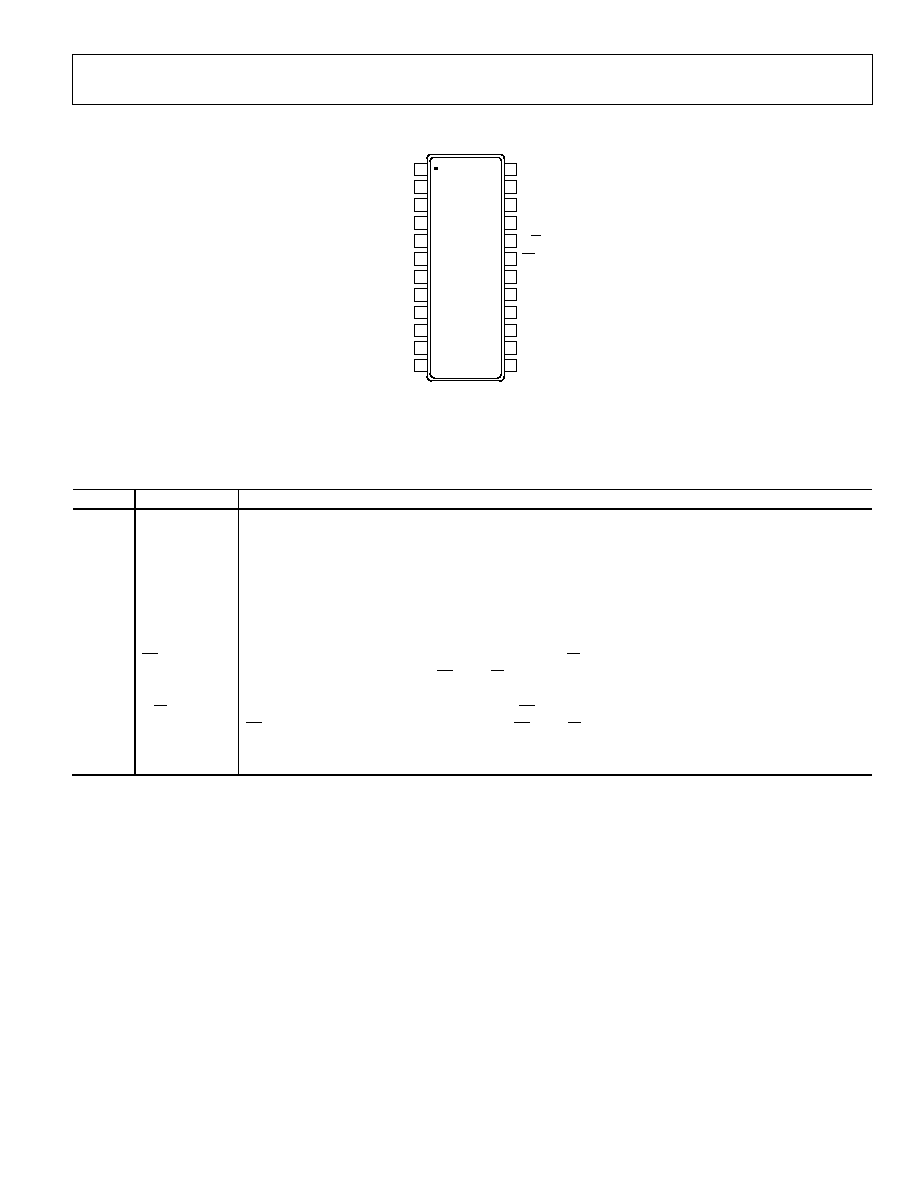
AD5428/AD5440/AD5447
Rev. 0 | Page 9 of 28
04462-0-006
R/W
CS
1
2
3
4
5
6
7
8
9
10
20
21
22
23
24
19
18
17
16
15
14
13
12
11
I
OUT
A
R
FB
A
V
REF
A
DB11
DAC A/B
DGND
AGND
R
FB
B
V
REF
B
V
DD
DB0 (LSB)
DB10
DB9
DB6
DB7
DB8
DB1
DB2
DB5
DB4
DB3
I
OUT
B
AD5447
TOP VIEW
(Not to Scale)
Figure 6. Pin Configuration 24-Lead TSSOP (RU-24)
Table 6. AD5447 Pin Function Descriptions
Pin No.
Mnemonic
Function
1
AGND
DAC Ground pin. Typically, this pin should be tied to the analog ground of the system, but may be biased to
achieve single-supply operation.
2, 24
I
OUT
A, I
OUT
B
DAC Current Outputs.
3, 23
R
FB
A, R
FB
B
DAC Feedback Resistor Pins. Establish voltage output for the DAC by connecting to external amplifier output.
4, 22
V
REF
A, V
REF
B
DAC Reference Voltage Input Terminals.
5
DGND
Digital Ground Pin.
6
DAC A/B
Selects DAC A or B. Low selects DAC A, or, alternatively, high selects DAC B.
7 to 18
DB11 to DB0
Parallel Data Bits 11 through 0.
19
CS
Chip Select Input. Active low. Used in conjunction with R/W to load parallel data to the input latch or to read
data from the DAC register. When CS and R/W are held low, the latches are transparent; any changes on the
data lines will be reflected on the relevant DAC output.
20
R/W
Read/Write. When low, used in conjunction with CS to load parallel data. When high, used in conjunction with
CS to read back contents of DAC register. When CS and R/W are held low, the latches are transparent; any
changes on the data lines are reflected on the relevant DAC output.
21
V
DD
Positive Power Supply Input. This part can be operated from a supply of 2.5 V to 5.5 V.

AD5428/AD5440/AD5447
Rev. 0 | Page 10 of 28
TERMINOLOGY
Relative Accuracy
Relative accuracy or endpoint nonlinearity is a measure of the
maximum deviation from a straight line passing through the
endpoints of the DAC transfer function. It is measured after
adjusting for zero and full scale and is typically expressed in
LSBs or as a percentage of full-scale reading.
Differential Nonlinearity
Differential nonlinearity is the difference between the measured
change and the ideal 1 LSB change between any two adjacent
codes. A specified differential nonlinearity of -1 LSB max over
the operating temperature range ensures monotonicity.
Gain Error
Gain error or full-scale error is a measure of the output error
between an ideal DAC and the actual device output. For these
DACs, ideal maximum output is V
REF
≠ 1 LSB. Gain error of the
DACs is adjustable to zero with external resistance.
Output Leakage Current
Output leakage current flows in the DAC ladder switches when
these are turned off. For the I
OUT
1 terminal, it can be measured
by loading all 0s to the DAC and measuring the I
OUT
1 current.
Minimum current flows in the I
OUT
2 line when the DAC is
loaded with all 1s.
Output Capacitance
Capacitance from I
OUT
1 or I
OUT
2 to AGND.
Output Current Settling Time
This is the amount of time it takes for the output to settle to a
specified level for a full-scale input change. For these devices, it
is specified with a 100 resistor to ground.
Digital-to-Analog Glitch lmpulse
The amount of charge injected from the digital inputs to the
analog output when the inputs change state. This is normally
specified as the area of the glitch in either pA-secs or nV-secs
depending upon whether the glitch is measured as a current or
voltage signal.
Digital Feedthrough
When the device is not selected, high frequency logic activity on
the device digital inputs is capacitively coupled through the
device to show up as noise on the I
OUT
pins and subsequently
into the following circuitry. This noise is digital feedthrough.
Multiplying Feedthrough Error
This is the error due to capacitive feedthrough from the DAC
reference input to the DAC I
OUT
1 terminal, when all 0s are
loaded to the DAC.
Total Harmonic Distortion (THD)
The DAC is driven by an ac reference. The ratio of the rms sum
of the harmonics of the DAC output to the fundamental value is
the THD. Usually only the lower-order harmonics are included,
such as second to fifth.
(
)
1
2
5
2
4
2
3
2
2
log
20
V
V
V
V
V
THD
+
+
+
=
Digital Intermodulation Distortion
Second-order intermodulation distortion (IMD) measurements
are the relative magnitude of the fa and fb tones generated
digitally by the DAC and the second-order products at 2fa - ffb
and 2fb - fa.
Spurious-Free Dynamic Range (SFDR)
SFDR is the usable dynamic range of a DAC before spurious
noise interferes or distorts the fundamental signal. SFDR is the
measure of difference in amplitude between the fundamental
and the largest harmonically- or nonharmonically-related spur
from dc to full Nyquist bandwidth (half the DAC sampling rate,
or fs/2). Narrow-band SFDR is a measure of SFDR over an
arbitrary window size, in this case 50%, of the fundamental.
Digital SFDR is a measure of the usable dynamic range of the
DAC when the signal is digitally generated sine wave.

AD5428/AD5440/AD5447
Rev. 0 | Page 11 of 28
TYPICAL PERFORMANCE CHARACTERISTICS
≠0.20
≠0.15
≠0.10
≠0.05
0
0.05
INL (
L
SB)
0.10
0.15
0.20
04462-0-007
0
50
100
150
200
250
CODE
T
A
= 25įC
V
REF
= 10V
V
DD
= 5V
Figure 7. INL vs. Code (8-Bit DAC)
≠0.5
≠0.4
≠0.3
≠0.2
≠0.1
0
0.1
0.2
0.3
0.4
0.5
INL (
L
SB)
04462-0-008
0
200
400
600
800
1000
CODE
T
A
= 25įC
V
REF
= 10V
V
DD
= 5V
Figure 8. INL vs. Code (10-Bit DAC)
≠1.0
≠0.8
≠0.6
≠0.4
≠0.2
0
0.2
0.4
0.6
0.8
1.0
INL (
L
SB)
2000
1500
500
1000
0
2500
3000
3500
4000
CODE
04462-0-009
T
A
= 25įC
V
REF
= 10V
V
DD
= 5V
Figure 9. INL vs. Code (12-Bit DAC)
≠0.20
≠0.15
≠0.10
≠0.05
0
0.05
DNL (LS
B
)
0.10
0.15
0.20
04462-0-010
0
50
100
150
200
250
CODE
T
A
= 25įC
V
REF
= 10V
V
DD
= 5V
Figure 10. DNL vs. Code (8-Bit DAC)
≠0.5
≠0.4
≠0.3
≠0.2
≠0.1
0
0.1
0.2
0.3
0.4
0.5
DNL (LS
B
)
04462-0-011
0
200
400
600
800
1000
CODE
T
A
= 25įC
V
REF
= 10V
V
DD
= 5V
Figure 11. DNL vs. Code (10-Bit DAC)
≠1.0
≠0.8
≠0.6
≠0.4
≠0.2
0
0.2
0.4
0.6
0.8
1.0
DNL (LS
B
)
2000
1500
500
1000
0
2500
3000
3500
4000
CODE
04462-0-012
T
A
= 25įC
V
REF
= 10V
V
DD
= 5V
Figure 12. DNL vs. Code (12-Bit DAC)
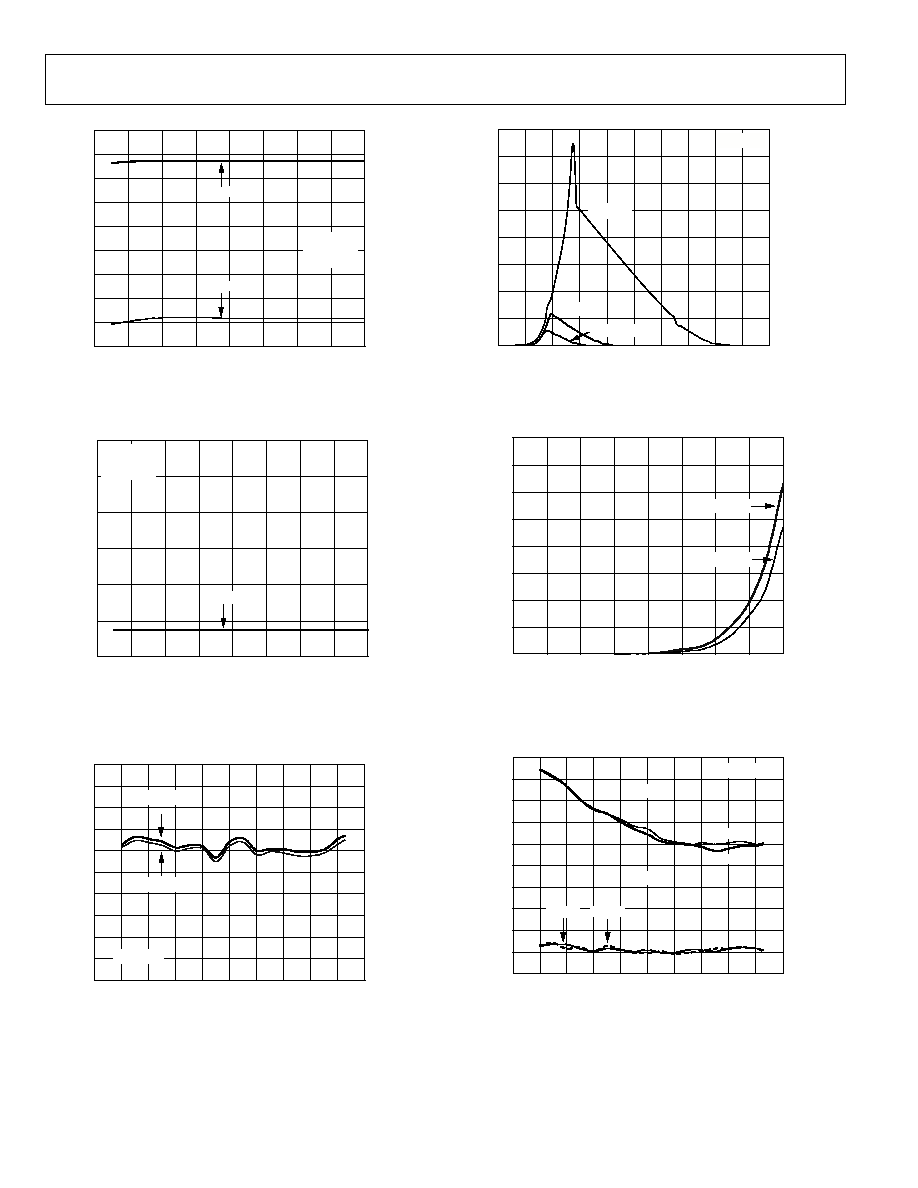
AD5428/AD5440/AD5447
Rev. 0 | Page 12 of 28
≠0.3
≠0.2
≠0.1
0
0.1
0.2
0.3
0.4
0.5
0.6
INL (
L
SB)
6
5
3
4
2
7
8
9
10
REFERENCE VOLTAGE
04462-0-013
MAX INL
MIN INL
T
A
= 25įC
V
REF
= 10V
V
DD
= 5V
Figure 13. INL vs. Reference Voltage
≠0.70
≠0.65
≠0.60
≠0.55
≠0.50
≠0.45
≠0.40
DNL (LS
B
)
6
5
3
4
2
7
8
9
REFERENCE VOLTAGE
04462-0-014
10
MIN DNL
T
A
= 25įC
V
REF
= 10V
V
DD
= 5V
Figure 14. DNL vs. Reference Voltage
≠5
≠4
≠3
≠2
≠1
0
1
2
3
4
5
E
RROR (mV
)
≠60
≠40
≠20
0
20
40
60
80
100
120
140
TEMPERATURE (įC)
04462-0-015
V
DD
= 5V
V
DD
= 2.5V
V
REF
= 10V
Figure 15. Gain Error vs. Temperature
INPUT VOLTAGE (V)
CURRE
NT (mA)
8
5
0
5.0
7
6
3
1
4
2
4.5
4.0
3.5
3.0
2.5
2.0
1.5
1.0
0.5
0
T
A
= 25
į
C
V
DD
= 5V
V
DD
= 3V
V
DD
= 2.5V
04462-0-022
Figure 16. Supply Current vs. Logic Input Voltage
0
0.2
0.4
0.6
0.8
1.0
I
OUT
LE
AKAGE
(nA)
1.2
1.4
1.6
40
20
≠20
0
≠40
60
80
100
120
TEMPERATURE (įC)
04462-0-023
I
OUT
1 V
DD
5V
I
OUT
1 V
DD
3V
Figure 17. I
OUT
1 Leakage Current vs. Temperature
0
0.05
0.10
0.15
0.20
0.25
0.30
0.35
0.40
0.45
0.50
CURRE
NT (
Ķ
A)
≠60
≠40
≠20
0
20
40
60
80
100
120
140
TEMPERATURE (įC)
04462-0-024
T
A
= 25įC
V
DD
= 5V
V
DD
= 2.5V
ALL 0s
ALL 1s
ALL 0s
ALL 1s
Figure 18. Supply Current vs. Temperature

AD5428/AD5440/AD5447
Rev. 0 | Page 13 of 28
0
2
4
6
8
10
12
14
I
DD
(mA)
10k
1k
10
100
1
100k
1M
10M
100M
FREQUENCY (Hz)
04462-0-025
T
A
= 25įC
LOADING ZS TO FS
V
DD
= 5V
V
DD
= 3V
V
DD
= 2.5V
Figure 19. Supply Current vs. Update Rate
≠102
≠66
≠54
≠42
≠30
≠18
≠6
6
1
100
1k
10k
100k
1M
10M
100M
FREQUENCY (Hz)
GAIN (
d
B)
T
A
= 25
į
C
LOADING
ZS TO FS
0
≠60
≠48
≠36
≠24
≠12
≠84
≠72
≠78
≠90
≠96
T
A
= 25
į
C
V
DD
= 5V
V
REF
=
Ī
3.5V
INPUT
C
COMP
= 1.8pF
AD8038 AMPLIFIER
ALL ON
DB11
DB10
DB9
DB8
DB7
DB6
DB5
DB4
DB3
DB2
DB1
DB0
ALL OFF
04462-0-026
10
Figure 20. Reference Multiplying Bandwidth vs. Frequency and Code
≠0.8
≠0.6
≠0.4
≠0.2
0
0.2
GAIN (
d
B)
10k
1k
10
100
1
100k
1M
10M
100M
FREQUENCY (Hz)
04462-0-027
T
A
= 25įC
V
DD
= 5V
V
REF
= Ī3.5V
C
COMP
= 1.8pF
AD8038 AMPLIFIER
Figure 21. Reference Multiplying Bandwidth≠All Ones Loaded
≠9
≠6
≠3
0
3
10k
100k
1M
10M
100M
FREQUENCY (Hz)
T
A
= 25įC
V
DD
= 5V
GAIN (
d
B)
04462-0-028
V
REF
=
Ī
2V, AD8038 C
C
1.47pF
V
REF
=
Ī
2V, AD8038 C
C
1pF
V
REF
=
Ī
0.15V, AD8038 C
C
1pF
V
REF
=
Ī
0.15V, AD8038 C
C
1.47pF
V
REF
=
Ī
3.51V, AD8038 C
C
1.8pF
Figure 22. Reference Multiplying Bandwidth vs. Frequency and
Compensation Capacitor
≠0.010
≠0.005
0.005
0.025
0.035
0.045
0.015
0
0.020
0.030
0.040
0.010
OUTPUT VOLTAGE (V)
0
20
40
60
80
100
120
140
160
180
200
TIME (ns)
04462-0-041
T
A
= 25įC
V
REF
= 0V
AD8038 AMPLIFIER
C
COMP
= 1.8pF
7FF TO 800H
800 TO 7FFH
V
DD
= 5V
V
DD
= 3V
V
DD
= 3V
V
DD
= 5V
Figure 23. Midscale Transition, V
REF
= 0 V
OUTPUT VOLTAGE (V)
0
20
40
60
80
100
120
140
160
180
200
TIME (ns)
04462-0-042
≠1.77
≠1.76
≠1.75
≠1.74
≠1.73
≠1.72
≠1.71
≠1.70
≠1.69
≠1.68
7FF TO 800H
800 TO 7FFH
V
DD
= 5V
V
DD
= 3V
V
DD
= 3V
V
DD
= 5V
T
A
= 25įC
V
REF
= 3.5V
AD8038 AMPLIFIER
C
COMP
= 1.8pF
Figure 24. Midscale Transition, V
REF
= 3.5 V
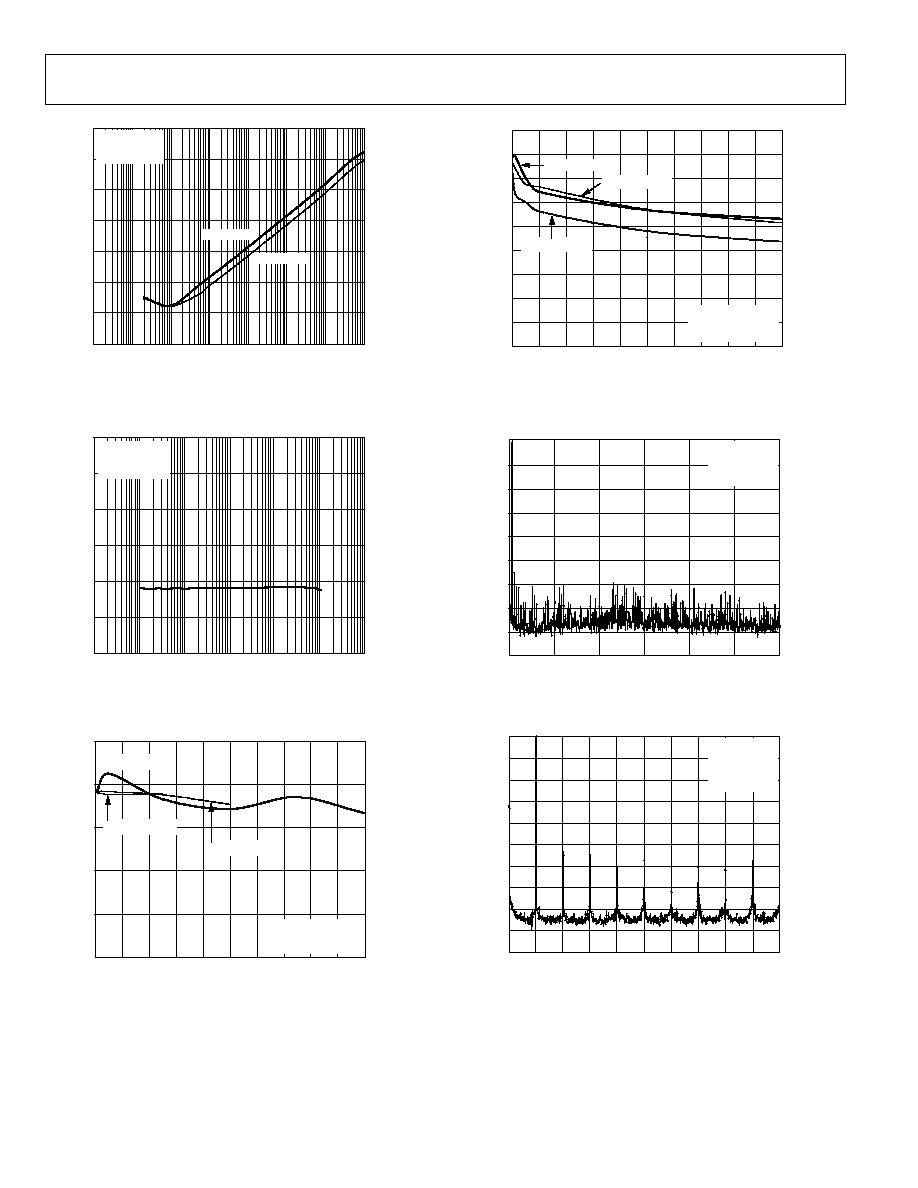
AD5428/AD5440/AD5447
Rev. 0 | Page 14 of 28
≠120
≠100
≠80
≠60
0
20
1
100
1k
10k
100k
1M
10M
FREQUENCY (Hz)
≠40
≠20
T
A
= 25
į
C
V
DD
= 3V
AMP = AD8038
FULL SCALE
ZERO SCALE
PSRR (
d
B)
04462-0-043
10
Figure 25. Power Supply Rejection vs. Frequency
≠90
≠85
≠80
≠75
≠70
≠65
≠60
THD + N (dB)
100
1k
1
10
10k
100k
1M
FREQUENCY (Hz)
04462-0-044
T
A
= 25įC
V
DD
= 3V
V
REF
= 3.5V p-p
Figure 26. THD + Noise vs. Frequency
0
20
40
60
80
100
S
F
DR (dB)
0
20
40
60
80
100
120
140
160
180
200
f
OUT
(kHz)
04462-0-045
T
A
= 25įC
V
REF
= 3.5V
AD8038 AMPLIFIER
MCLK = 1MHz
MCLK = 200kHz
MCLK = 0.5MHz
Figure 27. Wideband SFDR vs. f
OUT
Frequency
0
10
20
30
40
50
60
70
80
90
SFD
R
(
d
B
)
0
100
200
300
400
500
600
700
800
900 1000
f
OUT
(kHz)
04462-0-046
MCLK = 5MHz
MCLK = 10MHz
MCLK = 25MHz
T
A
= 25įC
V
REF
= 3.5V
AD8038 AMPLIFIER
Figure 28. Wideband SFDR vs. f
OUT
Frequency
04462-0-047
≠90
≠70
≠50
≠30
≠10
S
F
DR (dB)
0
FREQUENCY (MHz)
≠80
≠60
≠40
≠20
0
T
A
= 25
į
C
V
DD
= 5V
AMP = AD8038
65k CODES
2
4
6
8
10
12
Figure 29. Wideband SFDR, f
OUT
= 100 kHz, Clock = 25 MHz
044620-048
≠100
≠70
≠50
≠30
≠10
S
F
DR (dB)
0
FREQUENCY (MHz)
≠80
≠60
≠40
≠20
0
T
A
= 25
į
C
V
DD
= 5V
AMP = AD8038
65k CODES
0.5
1.5
3.0
3.5
4.0
1.0
2.0
2.5
4.5
5.0
≠90
Figure 30. Wideband SFDR, f
OUT
= 500 kHz, Clock = 10 MHz
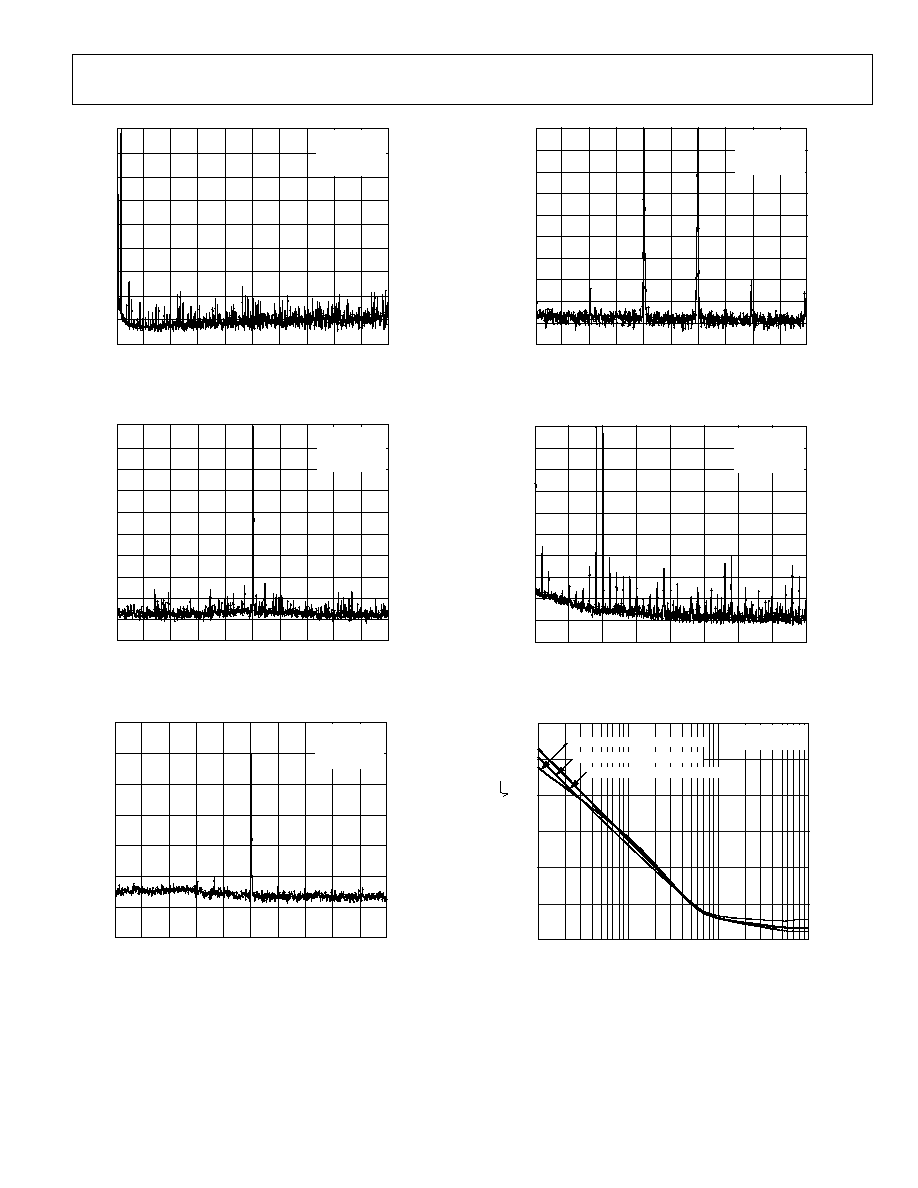
AD5428/AD5440/AD5447
Rev. 0 | Page 15 of 28
04462-0-049
≠90
≠70
≠50
≠30
≠10
S
F
DR (dB)
0
FREQUENCY (MHz)
≠80
≠60
≠40
≠20
0
0.5
1.5
3.0
3.5
4.0
1.0
2.0
2.5
4.5
5.0
T
A
= 25
į
C
V
DD
= 5V
AMP = AD8038
65k CODES
Figure 31. Wideband SFDR, f
OUT
= 50 kHz, Clock = 10 MHz
04462-0-050
FREQUENCY (MHz)
T
A
= 25
į
C
V
DD
= 3V
AMP = AD8038
65k CODES
≠100
≠70
≠50
≠30
≠10
SFD
R
(
d
B
)
250
750
300
350
400
650
700
≠80
≠60
≠40
≠20
0
≠90
450
500
550
600
Figure 32. Narrow-Band Spectral Response, f
OUT
= 500 kHz, Clock = 25 MHz
04462-0-051
≠120
≠60
≠20
S
F
DR (dB)
50
150
FREQUENCY (MHz)
60
70
80
130
140
≠80
≠40
0
20
≠100
90
100
110
120
T
A
= 25
į
C
V
DD
= 3V
AMP = AD8038
65k CODES
Figure 33. Narrow-Band SFDR, f
OUT
= 100 kHz, Clock = 25 MHz
04462-0-052
FREQUENCY (MHz)
≠100
≠70
≠50
≠30
≠10
(dB)
70
120
75
80
85
115
≠80
≠60
≠40
≠20
0
≠90
90
100
105
110
T
A
= 25
į
C
V
DD
= 3V
AMP = AD8038
65k CODES
95
Figure 34. Narrow-Band IMD, f
OUT
= 90 kHz, 100 kHz, Clock = 10 MHz
04462-0-053
≠100
≠40
≠20
(dB)
≠50
≠30
≠10
≠90
≠60
≠70
≠80
0
400
FREQUENCY (kHz)
50
300
350
100
150
200
250
0
T
A
= 25
į
C
V
DD
= 5V
AMP = AD8038
65k CODES
Figure 35. Wideband IMD, f
OUT
= 90 kHz, 100 kHz, Clock = 25 MHz
100
1k
10k
100k
FREQUENCY (Hz)
T
A
= 25
į
C
AMP = AD8038
FULL SCALE LOADED TO DAC
ZERO SCALE LOADED TO DAC
04462-0-054
0
50
100
150
200
250
300
OUTP
UT NOIS
E
(nV
/
Hz)
MIDSCALE LOADED TO DAC
Figure 36. Output Noise Spectral Density

AD5428/AD5440/AD5447
Rev. 0 | Page 16 of 28
GENERAL DESCRIPTION
CIRCUIT OPERATION
Unipolar Mode
The AD5428, AD5440 and AD5447 are dual 8-, 10- and 12-bit
current output DACs consisting of a standard inverting R-2R
ladder configuration. A simplified diagram for the 8-bit
AD5428 is shown in Figure 37. The feedback resistor R
FB
has a
value of R. The value of R is typically 10 k (minimum 8 k
and maximum 12 k). If I
OUT
1 and I
OUT
2 are kept at the same
potential, a constant current flows in each ladder leg, regardless
of digital input code. Therefore, the input resistance presented
at V
REF
is always constant and nominally of value R. The DAC
output (I
OUT
) is code dependent, producing various resistances
and capacitances. External amplifier choice should take into
account the variation in impedance generated by the DAC on
the amplifier's inverting input node.
Using a single op amp, these devices can easily be configured to
provide 2-quadrant multiplying operation or a unipolar output
voltage swing, as shown in Figure 38. When an output amplifier
is connected in unipolar mode, the output voltage is given by
n
REF
OUT
D
V
V
2
/
◊
-
=
where D is the fractional representation of the digital word
loaded to the DAC and n is the resolution of the DAC.
D = 0 to 255 (8-bit AD5428)
= 0 to 1023 (10-bit AD5440)
= 0 to 4095 (12-bit AD5447)
04462-0-029
V
REF
DAC DATA LATCHES
AND DRIVERS
R
FB
A
I
OUT
1
I
OUT
2
R
R
R
R
2R
2R
2R
2R
2R
S1
S2
S3
S8
Note that the output voltage polarity is opposite to the V
REF
polarity for dc reference voltages. These DACs are designed to
operate with either negative or positive reference voltages. The
VDD power pin is only used by the internal digital logic to
drive the on and off states of the DAC switches.
These DACs are also designed to accommodate ac reference
input signals in the range of ≠10 V to +10 V.
Figure 37. Simplified Ladder
With a fixed 10 V reference, the circuit in Figure 8 gives a
unipolar 0 V to ≠10 V output voltage swing. When V
IN
is an ac
signal, the circuit performs 2-quadrant multiplication.
Access is provided to the V
REF
, R
FB
, and I
OUT
terminals of DAC A
and DAC B, making the device extremely versatile and allowing
it to be configured in several different operating modes, for
example, to provide a unipolar output, 4-quadrant multiplica-
tion in bipolar mode or in single-supply modes of operation.
Note that a matching switch is used in series with the internal
R
FB
feedback resistor. If users attempt to measure R
FB
, power
must be applied to V
DD
to achieve continuity.
The following table shows the relationship between digital
code and the expected output voltage for unipolar operation
(AD5428, 8-bit device).
Table 7. Unipolar Code Table
Digital Input
Analog Output (V)
1111
1111
≠V
REF
(255/256)
1000
0000
≠V
REF
(128/256) = ≠V
REF
/2
0000
0001
≠V
REF
(1/256)
0000
0000
≠V
REF
(0/256) = 0
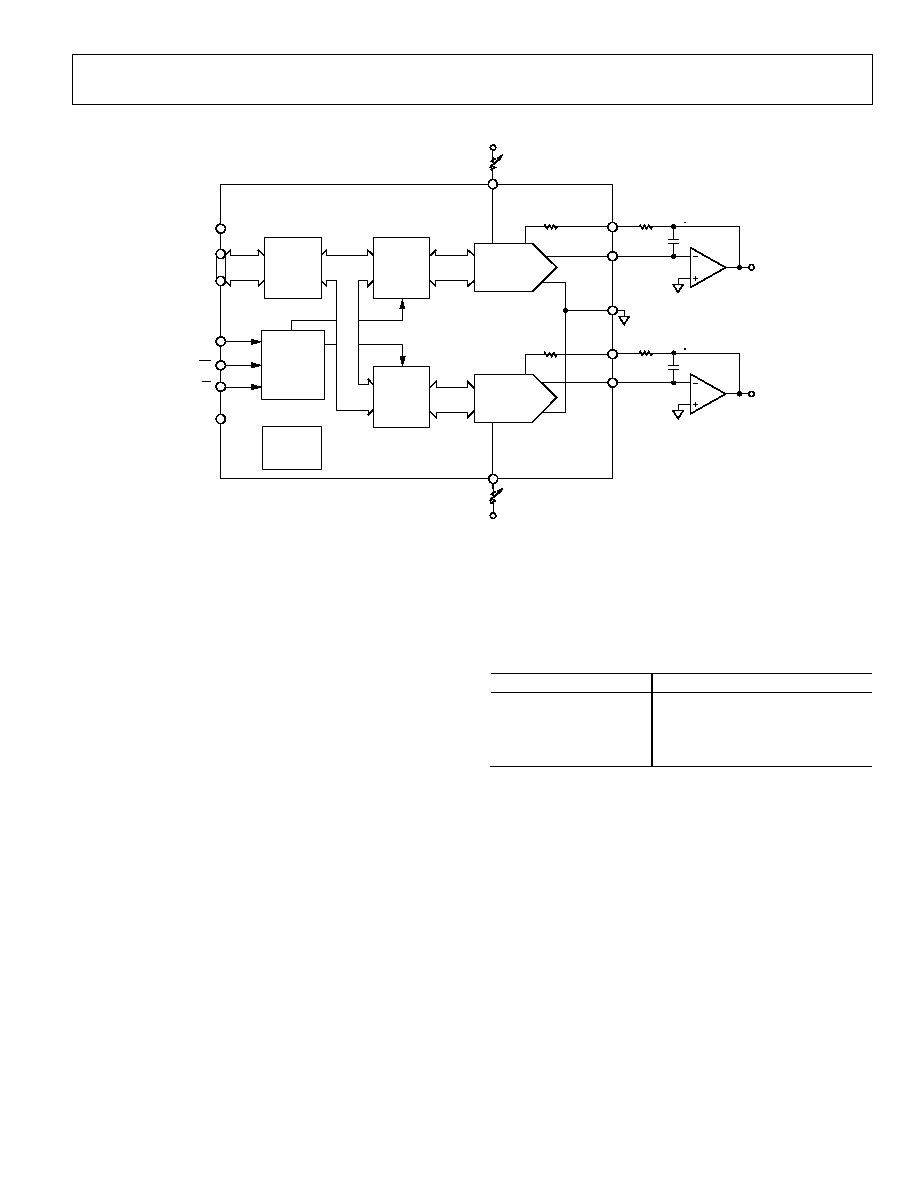
AD5428/AD5440/AD5447
Rev. 0 | Page 17 of 28
04462-0-030
CONTROL
LOGIC
INPUT
BUFFER
DATA
INPUTS
I
OUT
A
DB0
DAC A/B
CS
R/W
DGND
DB7
DB9
DB11
I
OUT
B
AGND
AD5428/AD5440/AD5447
LATCH
LATCH
AGND
8-/10-/12-BIT
R-2R DAC A
8-/10-/12-BIT
R-2R DAC B
POWER-ON
RESET
V
DD
V
REF
A
V
IN
A
(Ī10V)
V
REF
B
R
FB
A
R
FB
B
R
R
V
OUT
A
R1
1
V
IN
B
(Ī10V)
R3
1
R2
1
C1
2
AGND
V
OUT
B
R4
1
C2
2
1
2
R1, R2 AND R3, R4 USED ONLY IF GAIN ADJUSTMENT IS REQUIRED.
C1, C2 PHASE COMPENSATION (1pF≠2pF) IS REQUIRED WHEN USING
HIGH SPEED AMPLIFIERS TO PREVENT RINGING OR OSCILLATION.
NOTES:
Figure 38. Unipolar Operation
Bipolar Operation
In some applications, it may be necessary to generate full
4-quadrant multiplying operation or a bipolar output swing.
This can be easily accomplished by using another external
amplifier and some external resistors, as shown in Figure 39.
In this circuit, the second amplifier, A2, provides a gain of 2.
Biasing the external amplifier with an offset from the reference
voltage results in full 4-quadrant multiplying operation. The
transfer function of this circuit shows that both negative and
positive output voltages are created as the input data (D) is
incremented from code zero (V
OUT
= -V
REF
) to midscale
(V
OUT
= 0 V) to full scale (V
OUT
= +V
REF
). When connected in
bipolar mode, the output voltage is given by
(
)
REF
n
REF
OUT
V
D
V
V
-
◊
=
-1
2
/
where D is the fractional representation of the digital word
loaded to the DAC, and n is the number of bits.
D = 0 to 255 (AD5428)
= 0 to 1023 (AD5440)
= 0 to 4095 (AD5447)
When V
IN
is an ac signal, the circuit performs 4-quadrant
multiplication. Table 8 shows the relationship between digital
code and the expected output voltage for bipolar operation
(AD5428, 8-bit device).
Table 8. Bipolar Code Table
Digital Input
Analog Output (V)
1111 1111
+V
REF
(127/128)
1000 0000
0
0000 0001
≠V
REF
(127/128)
0000 0000
≠V
REF
(128/128)
Stability
In the I-to-V configuration, the IOUT of the DAC and the
inverting node of the op amp must be connected as close as
possible and proper PCB layout techniques must be employed.
Because every code change corresponds to a step function, gain
peaking may occur if the op amp has limited GBP and there is
excessive parasitic capacitance at the inverting node. This
parasitic capacitance introduces a pole into the open loop
response which can cause ringing or instability in the closed
loop applications circuit.
An optional compensation capacitor, C1, can be added in
parallel with R
FB
for stability, as shown in Figure 38 and in
Figure 39. Too small a value of C1 can produce ringing at the
output, while too large a value can adversely affect the settling
time. C1 should be found empirically, but 1 pF to2 pF is
generally adequate for the compensation.
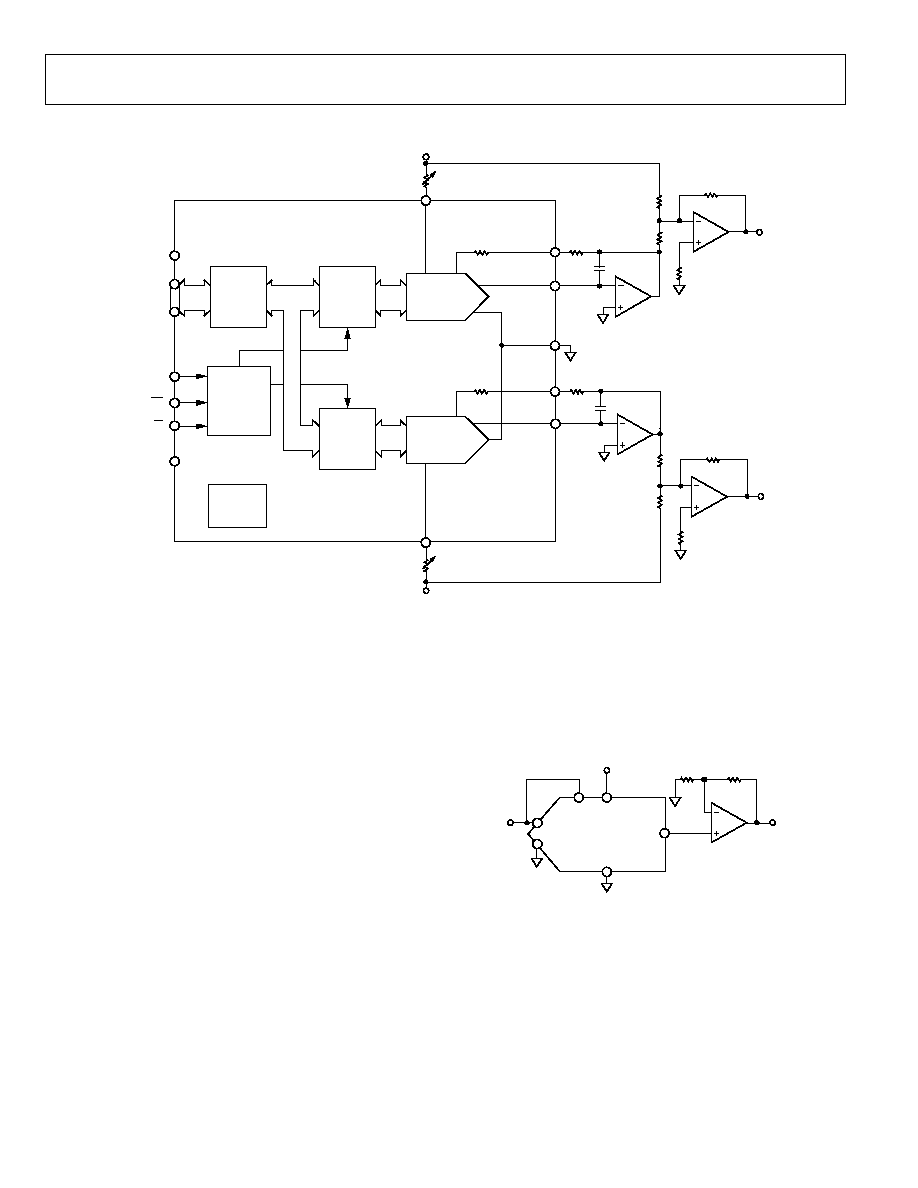
AD5428/AD5440/AD5447
Rev. 0 | Page 18 of 28
04462-0-031
CONTROL
LOGIC
INPUT
BUFFER
DATA
INPUTS
I
OUT
A
DB0
DAC A/B
CS
R/W
DGND
DB7
DB9
DB11
I
OUT
B
AGND
AD5428/AD5440/AD5447
LATCH
LATCH
AGND
8-/10-/12-BIT
R-2R DAC A
8-/10-/12-BIT
R-2R DAC B
POWER-ON
RESET
V
DD
V
REF
A
V
IN
A
(Ī10V)
V
REF
B
R
FB
A
R
FB
B
R
R
R2
1
V
OUT
A
R1
1
V
IN
B
(Ī10V)
R3
1
R6
2
20k
R5
20k
R8
20k
R11
5k
R12
5k
R7
2
10k
R9
2
10k
R10
2
20k
C1
2
AGND
AGND
AGND
V
OUT
B
R4
1
C2
2
A1
A3
A2
A4
1
2
3
R1, R2 AND R3, R4 USED ONLY IF GAIN ADJUSTMENT IS REQUIRED. ADJUST R1 FOR V
OUT
A = 0V WITH CODE 10000000 IN DAC A LATCH.
ADJUST R3 FOR V
OUT
B = 0V WITH CODE 10000000 IN DAC B LATCH.
MATCHING AND TRACKING IS ESSENTIAL FOR RESISTOR PAIRS R6, R7 AND R9, R10.
C1, C2 PHASE COMPENSATION (1pF≠2pF) MAY BE REQUIRED IF A1/A3 IS A HIGH SPEED AMPLIFIER.
NOTES:
Figure 39. Bipolar Operation (4-Quadrant Multiplication)
SINGLE-SUPPLY APPLICATIONS
Voltage-Switching Mode
Figure 40 shows these DACs operating in voltage-switching
mode. The reference voltage, V
IN
, is applied to the I
OUT
1 pin,
I
OUT
2 is connected to AGND, and the output voltage is available
at the V
REF
terminal. In this configuration, a positive reference
voltage results in a positive output voltage, making single-
supply operation possible. The output from the DAC is voltage
at constant impedance (the DAC ladder resistance), thus an
op amp is necessary to buffer the output voltage. The reference
input no longer sees constant input impedance, but one that
varies with code. So, the voltage input should be driven from a
low impedance source.
Note that V
IN
is limited to low voltages because the switches in
the DAC ladder no longer have the same source-drain drive
voltage. As a result, their on resistance differs and this degrades
the integral linearity of the DAC. Also, V
IN
must not go negative
by more than 0.3 V or an internal diode turns on, exceeding the
maximum ratings of the device. In this type of application, the
full range of multiplying capability of the DAC is lost.
04462-0-033
1
2
ADDITIONAL PINS OMITTED FOR CLARITY.
C1 PHASE COMPENSATION (1pF≠2pF) MAY BE REQUIRED
IF A1 IS A HIGH SPEED AMPLIFIER.
NOTES:
V
DD
V
IN
V
REF
V
DD
R
FB
GND
V
OUT
I
OUT
1
I
OUT
2
R
1
R
2
Figure 40. Single-Supply Voltage-Switching Mode
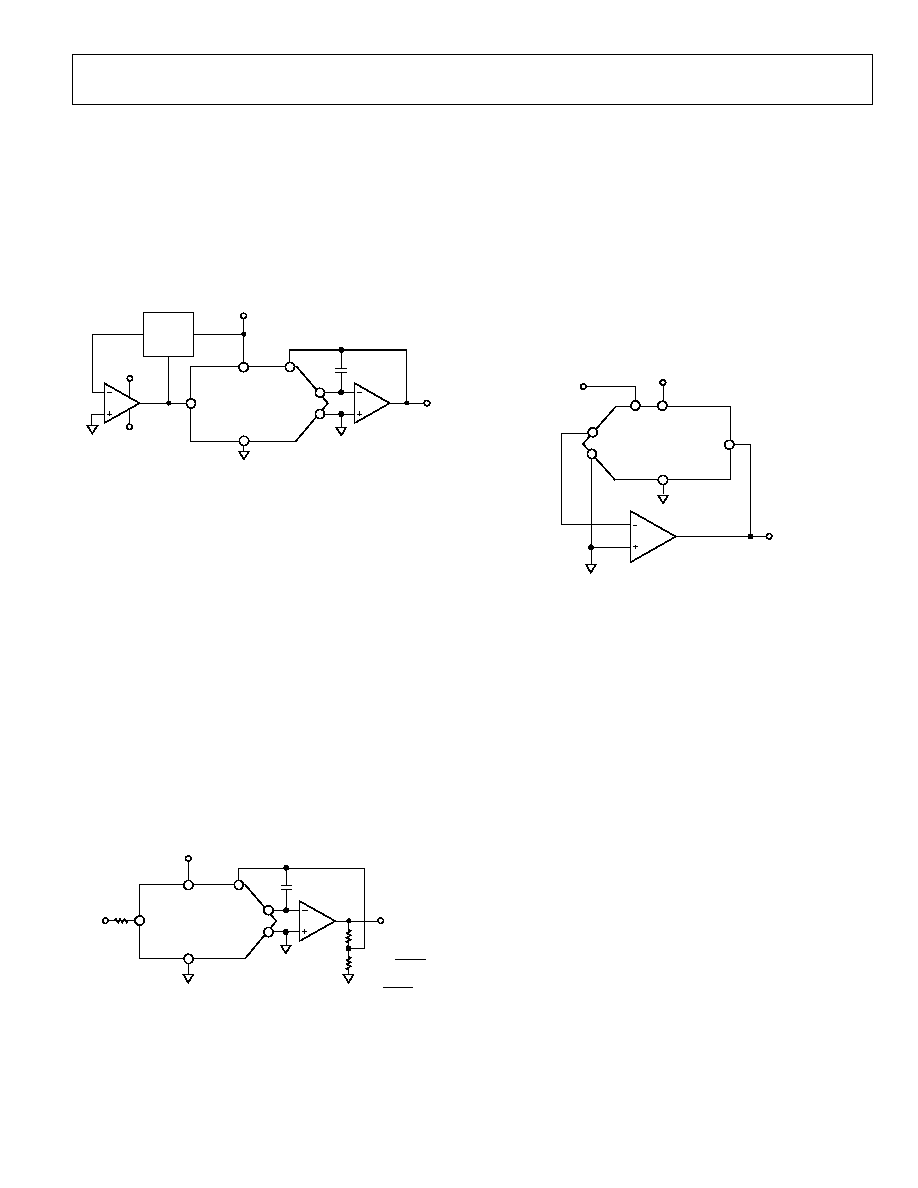
AD5428/AD5440/AD5447
Rev. 0 | Page 19 of 28
POSITIVE OUTPUT VOLTAGE
Note the output voltage polarity is opposite to the V
REF
polarity
for dc reference voltages. For a positive voltage output, an
applied negative reference to the input of the DAC is preferred
over the output inversion through an inverting amplifier
because of the resistor's tolerance errors. To generate a negative
reference, the reference can be level shifted by an op amp such
that the V
OUT
and GND pins of the reference become the virtual
ground and ≠2.5 V respectively, as shown in Figure 41.
04462-0-034
1
2
ADDITIONAL PINS OMITTED FOR CLARITY.
C1 PHASE COMPENSATION (1pF≠2pF) MAY BE REQUIRED
IF A1 IS A HIGH SPEED AMPLIFIER.
NOTES:
V
DD
= +5V
V
DD
C
1
V
IN
V
REF
R
FB
8-/10-/12-BIT
DAC
ADR03
1/2 AD8552
1/2 AD8552
GND
GND
V
OUT
V
OUT
=
0V to 2.5V
I
OUT
1
I
OUT
2
+5V
≠5V
≠2.5V
Figure 41. Positive Voltage Output with Minimum Components
ADDING GAIN
In applications where the output voltage is required to be
greater than V
IN
, gain can be added with another external
amplifier or it can also be achieved in a single stage. It is
important to take into consideration the effect of temperature
coefficients of the thin film resistors of the DAC. Simply placing
a resistor in series with the R
FB
resistor causes mismatches in the
temperature coefficients, resulting in larger gain temperature
coefficient errors. Instead, the circuit of Figure 42 shows the
recommended method of increasing the gain of the circuit. R
1
,
R
2
, and R
3
should all have similar temperature coefficients, but
they need not match the temperature coefficients of the DAC.
This approach is recommended in circuits where gains of >1
are required.
04462-0-035
1
2
ADDITIONAL PINS OMITTED FOR CLARITY.
C1 PHASE COMPENSATION (1pF≠2pF) MAY BE REQUIRED
IF A1 IS A HIGH SPEED AMPLIFIER.
NOTES:
V
DD
V
DD
C
1
V
IN
V
REF
R
FB
R
2
R
3
R
2
8-/10-/12-BIT
DAC
GND
V
OUT
I
OUT
1
I
OUT
2
R
2
+ R
3
R
2
GAIN =
R
1
=
R
2
R
3
R
2 +
R
3
Figure 42. Increasing Gain of Current Output DAC
USED AS A DIVIDER OR PROGRAMMABLE GAIN
ELEMENT
Current-steering DACs are very flexible and lend themselves to
many different applications. If this type of DAC is connected as
the feedback element of an op amp and R
FB
is used as the input
resistor as shown in Figure 43, then the output voltage is
inversely proportional to the digital input fraction D.
For D = 1-2
n
the output voltage is
(
)
n
IN
IN
OUT
V
D
V
V
2
1
/
/
-
-
=
-
=
V
OUT
V
DD
GND
V
IN
I
OUT
2
I
OUT
1
R
FB
V
DD
V
REF
NOTE:
ADDITIONAL PINS OMITTED FOR CLARITY
04462-0-040
Figure 43. Current-Steering DAC Used as a Divider or
Programmable Gain Element
As D is reduced, the output voltage increases. For small values
of the digital fraction D, it is important to ensure that the
amplifier does not saturate and also that the required accuracy
is met. For example, an 8-bit DAC driven with the binary code
0 ◊ 10 (00010000)--that is, 16 decimal--in the circuit of
Figure 43 should cause the output voltage to be 16 ◊V
IN
.
However, if the DAC has a linearity specification of Ī 0.5 LSB,
then D can, in fact, have the weight anywhere in the range
15.5/256 to 16.5/256 so that the possible output voltage is in the
range 15.5 V
IN
to 16.5 V
IN
--an error of 3% even though the
DAC itself has a maximum error of 0.2%.
DAC leakage current is also a potential error source in divider
circuits. The leakage current must be counterbalanced by an
opposite current supplied from the op amp through the DAC.
Because only a fraction, D, of the current into the V
REF
terminal
is routed to the I
OUT
1 terminal, the output voltage must change
to:
Output Error Voltage Due to DAC Leakage
(
)
D
R
Leakage
/
◊
=
where R is the DAC resistance at the VREF terminal. For a DAC
leakage current of 10 nA, R = 10 k and a gain (i.e, a/D) of 16,
the error voltage is 1.6 mV.

AD5428/AD5440/AD5447
Rev. 0 | Page 20 of 28
REFERENCE SELECTION
When selecting a reference for use with the AD54XX series of
current output DACs, pay attention to the reference's output
voltage temperature coefficient specification. This parameter
not only affects the full-scale error, but can also affect the
linearity (INL and DNL) performance. The reference
temperature coefficient should be consistent with the system
accuracy specifications. For example, an 8-bit system required
to hold its overall specification to within 1 LSB over the
temperature range 0į to 50įC dictates that the maximum system
drift with temperature should be less than 78 ppm/įC. A 12-bit
system with the same temperature range to overall specification
within 2 LSBs requires a maximum drift of 10 ppm/įC. By
choosing a precision reference with low output temperature
coefficient this error source can be minimized. Table 9 lists
some of the references available from Analog Devices, Inc. that
are suitable for use with this range of current output DACs.
AMPLIFIER SELECTION
The primary requirement for the current-steering mode is an
amplifier with low input bias currents and low input offset
voltage. The input offset voltage of an op amp is multiplied by
the variable gain (due to the code-dependent output resistance
of the DAC) of the circuit. A change in the noise gain between
two adjacent digital fractions produces a step change in the
output voltage due to the amplifier's input offset voltage. This
output voltage change is superimposed on the change in output
between the two codes and gives rise to a differential linearity
error, which if too large might cause the DAC to be nonmono-
tonic. The input offset voltage should be <1/4 LSB to ensure
monotonic behavior when stepping through codes.
The input bias current of an op amp also generates an offset at
the voltage output as a result of the bias current flowing in the
feedback resistor, R
FB
. Most op amps have input bias currents
low enough to prevent significant errors in 12-bit applications.
In voltage-switching circuits, common-mode rejection of the op
amp is important because it produces a code-dependent error at
the voltage output of the circuit. Most op amps have adequate
common-mode rejection for use at 8-, 10-, and 12-bit resolution.
Provided the DAC switches are driven from true wideband, low
impedance sources (V
IN
and AGND), they settle quickly. Thus,
the slew rate and settling time of a voltage-switching DAC
circuit is determined largely by the output op amp. To obtain
minimum settling time in this configuration, it is important to
minimize capacitance at the V
REF
node (voltage output node in
this application) of the DAC. This is done by using low input
capacitance buffer amplifiers and careful board design.
Most single-supply circuits include ground as part of the analog
signal range, which in turns requires an amplifier that can
handle rail-to-rail signals. Analog Devices, Inc. provides a large
variety of single-supply amplifiers.
PARALLEL INTERFACE
Data is loaded to the AD5428/ AD5440/ AD5447 in the format
of an 8-, 10-, or 12-bit parallel word. Control lines CS and R/W
allow data to be written to or read from the DAC register. A
write event takes place when CS and R/W are brought low, data
available on the data lines fills the shift register, and the rising
edge of CS latches the data and transfers the latched data word
to the DAC register. The DAC latches are not transparent, thus a
write sequence must consist of a falling and rising edge on CS to
ensure data is loaded to the DAC register and its analog
equivalent reflected on the DAC output.
A read event takes place when R/W is held high and CS is
brought low. Data is loaded from the DAC register back to the
input register and out onto the data line where it can be read
back to the controller for verification or diagnostic purposes.
The input and DAC registers of these devices are not
transparent, so a falling and rising edge of CS is required to load
each data-word.
MICROPROCESSOR INTERFACING
The AD5428/AD5440/AD5447 can be interfaced to a variety of
16-bit microcontrollers or DSP processors. Figure 44 shows the
AD54xx DAC interfaced to a generic 16-bit microcontroller/
DSP processor. Microprocessor interfacing to this family of
DACs is via a data bus that uses standard protocol compatible
with microcontrollers and DSP processors. The address decoder
is used to select DAC A or DAC B and also to load parallel data
to the input latch or to read data from the DAC using an AND
gate.
AD54XX*
DAC A/B
CS
WR
DB0 TO DB11
A0 TO AX
MICRO/DSP*
WR
DB0 TO DB11
A
ADDRESS
DECODER
DATA BUS
ADDRESS BUS
A + 1
04462-0-055
*ADDITIONAL PINS OMITTED FOR CLARITY
Figure 44. AD54xx to Parallel Interface
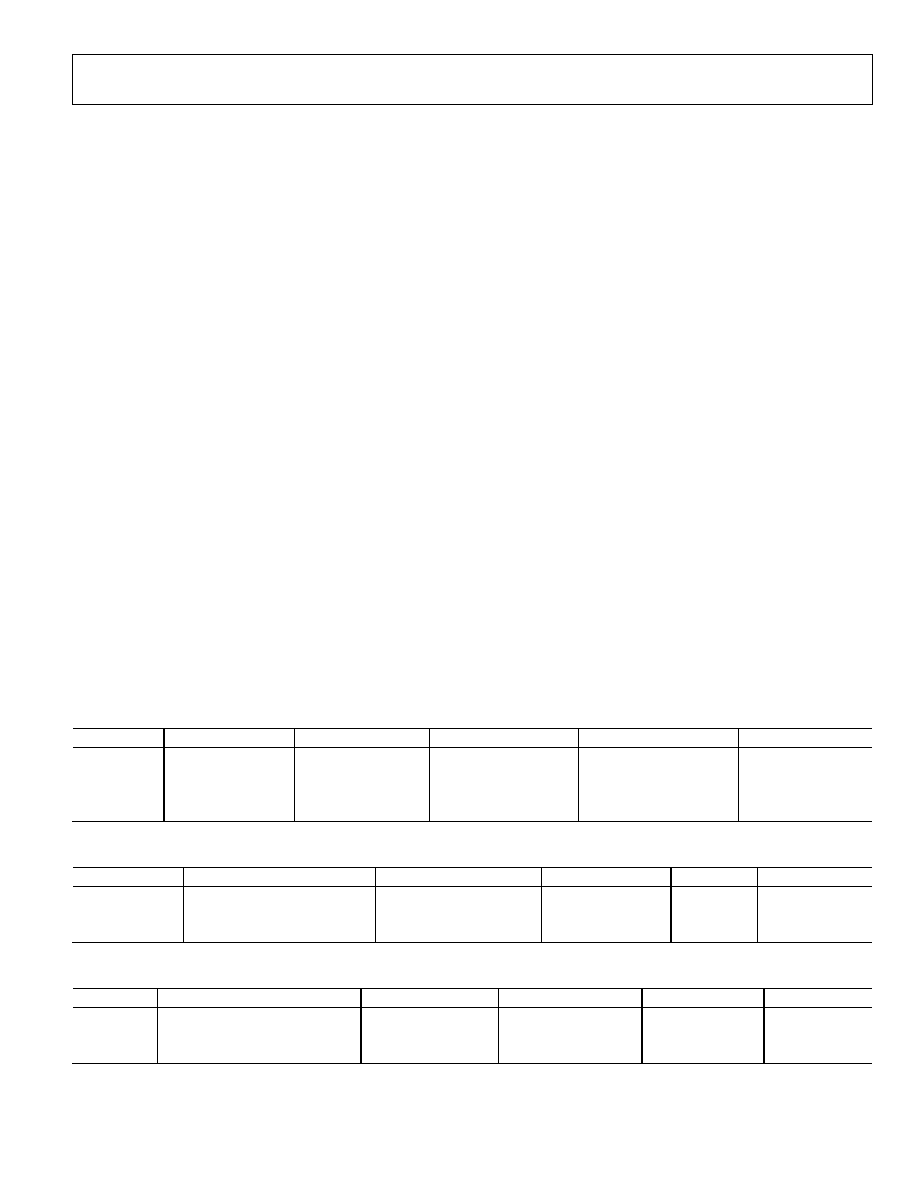
AD5428/AD5440/AD5447
Rev. 0 | Page 21 of 28
PCB LAYOUT AND POWER SUPPLY DECOUPLING
In any circuit where accuracy is important, careful
consideration of the power supply and ground return layout
helps to ensure the rated performance. The printed circuit
board on which the AD5428/AD5440/AD5447 is mounted
should be designed so that the analog and digital sections are
separated, and confined to certain areas of the board. If the
DAC is in a system where multiple devices require an AGND-
to-DGND connection, the connection should be made at one
point only. The star ground point should be established as close
as possible to the device.
These DACs should have ample supply bypassing of 10 ĶF in
parallel with 0.1 ĶF on the supply located as close to the package
as possible, ideally right up against the device. The 0.1 ĶF
capacitor should have low effective series resistance (ESR) and
effective series inductance (ESI), like the common ceramic types
that provide a low impedance path to ground at high
frequencies, to handle transient currents due to internal logic
switching. Low ESR 1 ĶF to 10 ĶF tantalum or electrolytic
capacitors should also be applied at the supplies to minimize
transient disturbance and filter out low frequency ripple.
Fast switching signals such as clocks should be shielded with
digital ground to avoid radiating noise to other parts of the
board, and should never be run near the reference inputs.
Avoid crossover of digital and analog signals. Traces on opposite
sides of the board should run at right angles to each other. This
reduces the effects of feedthrough on the board. A microstrip
technique is by far the best, but not always possible with a
double-sided board. In this technique, the component side of
the board is dedicated to ground plane while signal traces are
placed on the soldered side.
It is good practice to employ compact, minimum lead length
PCB layout design. Leads to the input should be as short as
possible to minimize IR drops and stray inductance.
The PCB metal traces between V
REF
and R
FB
should also be
matched to minimize gain error. To maximize on high
frequency performance, the I-to-V amplifier should be located
as close to the device as possible.
EVALUATION BOARD FOR THE DACS
The evaluation board consists of a DAC and a current to voltage
amplifier AD8065. Included on the evaluation board is a 10 V
reference, ADR01. An external reference may also be applied via
an SMB input.
The evaluation kit consists of a CD-ROM with self-installing
PC software to control the DAC. The software simply allows the
user to write a code to the device.
POWER SUPPLIES FOR THE EVALUATION BOARD
The board requires Ī12 V, and +5 V supplies. The +12 V V
DD
and Vss are used to power the output amplifier, while the +5 V
is used to power the DAC (V
DD1
) and transceivers (V
CC
).
Both supplies are decoupled to their respective ground plane
with 10ĶF tantalum and 0.1ĶF ceramic capacitors.
Table 9. Suitable ADI Precision References Recommended for Use with AD5428/AD5440/AD5447 DACs
Reference
Output Voltage
Initial Tolerance
Temperature Drift
0.1 Hz to 10 Hz noise
Package
ADR01
10 V
0.1%
3 ppm/įC
20 ĶV p-p
SC70, TSOT, SOIC
ADR02
5 V
0.1%
3 ppm/įC
10 ĶV p-p
SC70, TSOT, SOIC
ADR03
2.5 V
0.2%
3 ppm/įC
10 ĶV p-p
SC70, TSOT, SOIC
ADR425
5 V
0.04%
3 ppm/įC
3.4 ĶV p-p
MSOP, SOIC
Table 10. Precision ADI Op Amps Suitable for Use with AD5428/AD5440/AD5447 DACs
Part #
Max Supply Voltage V
V
OS
(max) ĶVI
B
(max) nA
I
B
(max) nA
GBP MHz
Slew Rate V/Ķs
OP97
Ī20
25
0.1
0.9
0.2
OP1177
Ī18
60
2
1.3
0.7
AD8551
+6
5
0.05
1.5
0.4
Table 11. High Speed ADI Op Amps Suitable for Use with AD5428/AD5440/AD5447 DACs
Part #
Max Supply Voltage V
BW @ A
CL
MHz
Slew Rate V/Ķs
V
OS
(max) ĶV
I
B
(max) nA
AD8065
Ī12
145
180
1500
0.01
AD8021
Ī12
200
100
1000
1000
AD8038
Ī5
350
425
3000
0.75
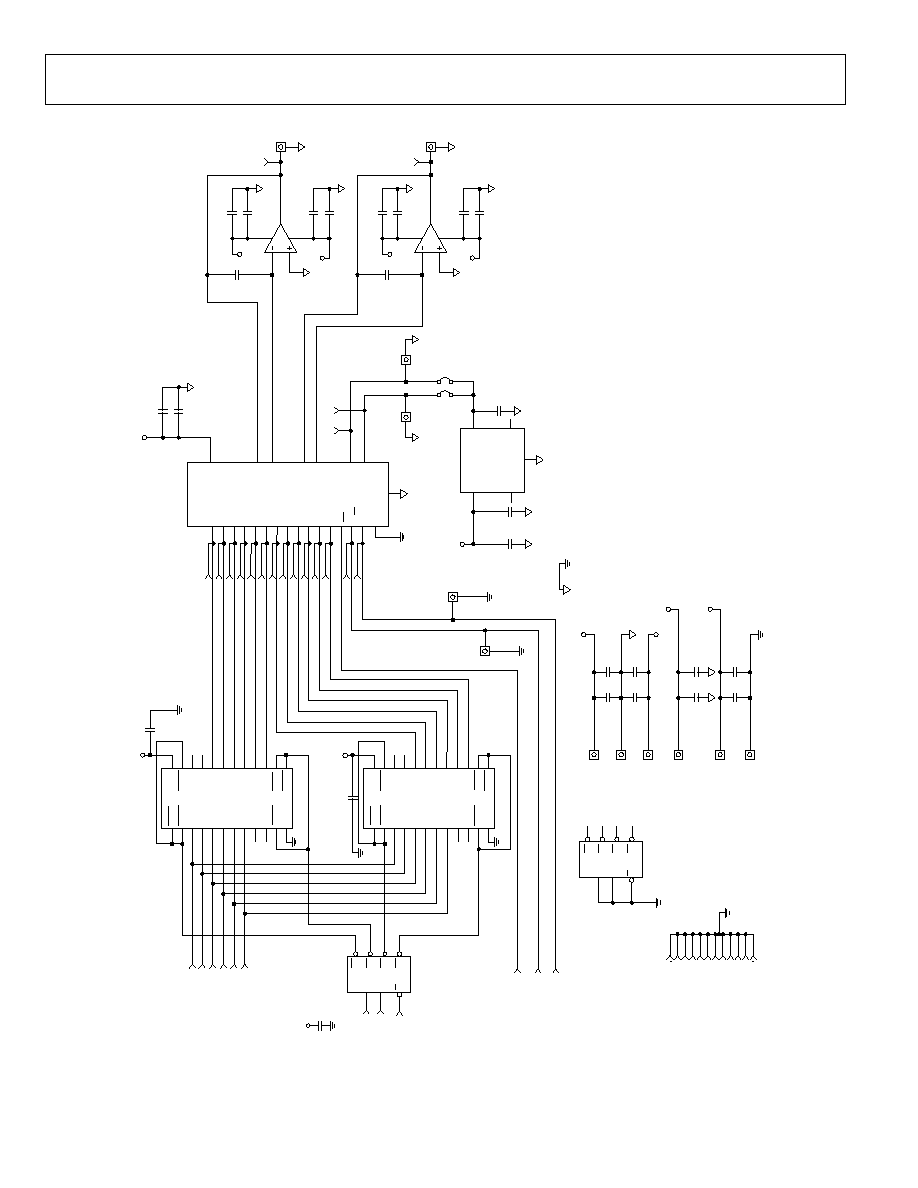
AD5428/AD5440/AD5447
Rev. 0 | Page 22 of 28
04464-0-023
V
DD
V
SS
U3
C7
1.
8pF
J1
7
4
3
2
6
V≠
V+
+
C11 10
Ķ
F
C9 10
Ķ
F
C12
0.
1
Ķ
F
C8
0.
1
Ķ
F
C3
10
Ķ
F
C14
10
Ķ
F
C16
10
Ķ
F
C18
10
Ķ
F
C20
10
Ķ
F
C4
0.
1
Ķ
F
C13
0.
1
Ķ
F
C15
0.
1
Ķ
F
C17
0.
1
Ķ
F
C17
0.
1
Ķ
F
DG
ND
C19
0.
1
Ķ
F
C2
0.
1
Ķ
F
C1
0.
1
Ķ
F
C10
0.
1
Ķ
F
+
+
C5 10
Ķ
F
C6
0.
1
Ķ
F
+
TP
1
O/P
A
V
DD
V
SS
U7
C22
1.
8pF
J6
7
4
3
2
6
V≠
V+
+
C25 10
Ķ
F
C23 10
Ķ
F
C26
0.
1
Ķ
F
C24
0.
1
Ķ
F
+
TP
4
TP
3
TP
2
O/P
B
V
DD
R
FB
B
V
DD
+V
IN
V
OUT
TRIM
GN
D
U1
AD5547
U6-
A
LK1
U2
2
5
3
4
1
V
DD
1
A
B
AG
ND
23
21
I
OUT
B
24
R
FB
A
3
I
OUT
A
2
V
RE
F
B
V
RE
F
A
J5
J2
EXT RE
F B
EXT RE
F A
22
4
1
17
18
1
3
1
4
2
2
2
1
2
0
1
9
2
3
2
4
1
5
1
6
5
6
1
2
1
1
1
0
9
8
7
2
1
3
4
B
5
B
4
O
E
A
B
L
E
A
B
B
0
B
1
B
2
B
3
C
E
B
A
B
7
B
6
A
2
A
3
G
N
D
C
E
A
B
A
7
A
6
A
5
A
4
O
E
B
A
L
E
B
A
A
0
A
1
5
6
1
2
1
1
1
0
9
8
7
2
1
3
4
B
5
B
4
O
E
A
B
L
E
A
B
B
0
B
1
B
2
B
3
C
E
B
A
B
7
B
6
A
2
A
3
G
N
D
C
E
A
B
A
7
A
6
A
5
A
4
O
E
B
A
L
E
B
A
A
0
A
1
3
1
2
A
0
A
1
V
CC
V
CC
V
C
C
V
CC
V
C
C
P
1
≠
3
1
P
1
≠
1
P
1
≠
8
P
1
≠
9
P
1
≠
3
6
P
1
≠
1
4
P
1
≠
7
P
1
≠
6
P
1
≠
5
P
1
≠
4
P
1
≠
3
P
1
≠
2
J
4
J
3
U5
U4
74ABT543
74A
BT543
1
7
1
8
1
3
1
4
2
2
2
1
1
1
1
2
9
1
0
5
4
7
6
2
0
1
9
2
3
2
4
1
5
1
6
D
B
0
1
8
D
B
1
1
7
D
B
7
1
1
D
B
8
1
0
D
B
9
9
D
B
1
0
8
D
B
1
1
7
C
S
1
9
R
W
2
0
6
D
B
6
1
2
D
B
5
1
3
D
B
4
1
4
D
B
3
1
5
D
B
2
1
6
5
D
G
N
D
D
G
N
D
D
G
N
D
D
B
0
D
B
1
D
B
7
D
B
8
D
B
9
D
B
1
0
D
B
1
1
C
S
R
/
W
D
A
C
_
A
/
B
D
B
6
D
B
5
D
B
4
D
B
3
D
B
2
E
Y
3
Y
2
Y
1
Y
0
U6-
B
1
3
1
5
1
4
A
0
A
1
E
Y
3
Y
2
Y
1
Y
0
P1
≠19
P1
≠20
P1
≠21
P1
≠22
P1
≠23
P1
≠24
P1
≠25
P1
≠26
P1
≠27
P1
≠28
P1
≠29
P1
≠30
P
2
≠
3
P
2
≠
2
P
2
≠
1
P
2
≠
4
A
G
N
D
V
SS
V
DD
1
V
DD
+
P
2
≠
6
P
2
≠
5
+
+
+
V
CC
Figure 45. Schematic of AD5428/AD5440/AD5447 Evaluation Board
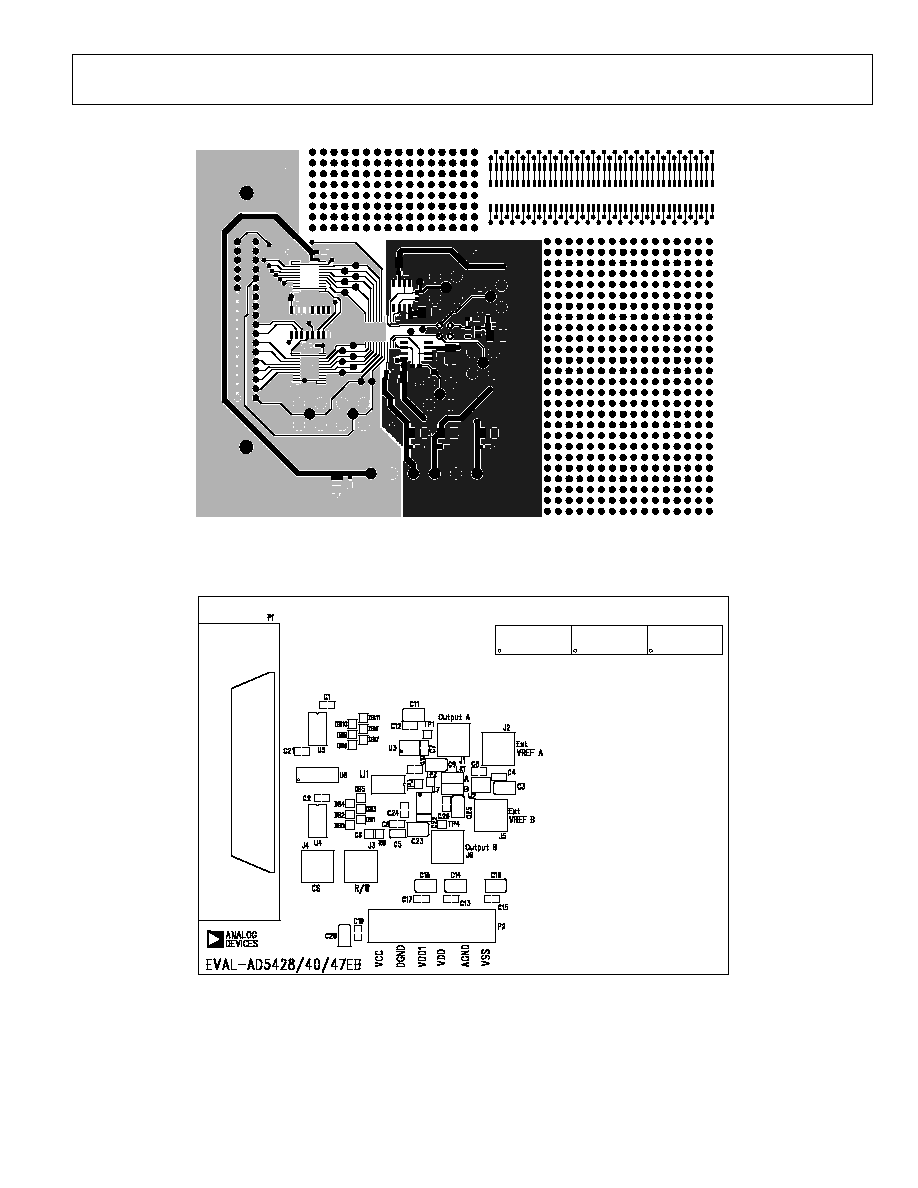
AD5428/AD5440/AD5447
Rev. 0 | Page 23 of 28
04462-0-036
Figure 46. Component-Side Artwork
04462-0-038
Figure 47. Silkscreen--Component-Side View (Top Layer)
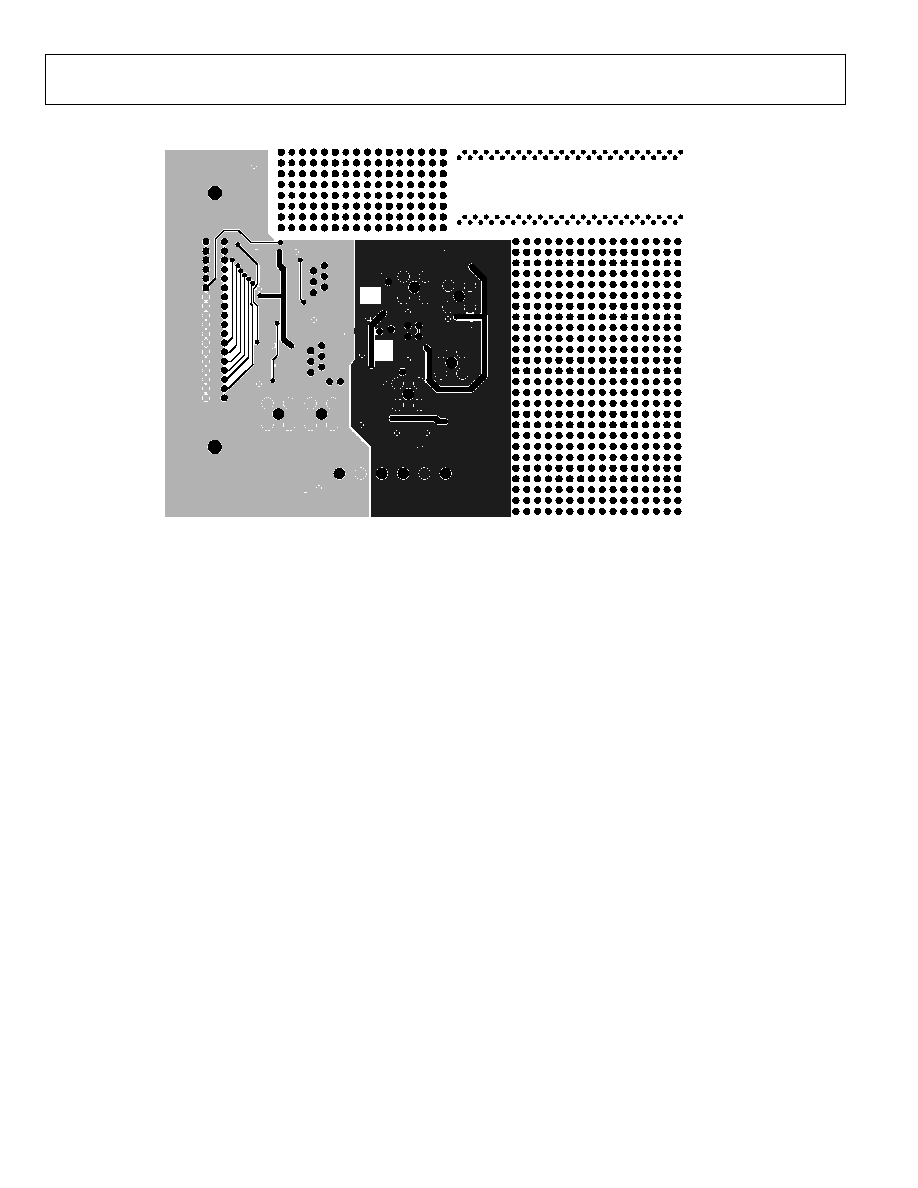
AD5428/AD5440/AD5447
Rev. 0 | Page 24 of 28
04462-0-039
Figure 48. Solder-Side Artwork

AD5428/AD5440/AD5447
Rev. 0 | Page 25 of 28
BILL OF MATERIALS
Table 12.
Name
Part Description
Value
Tolerance (%)
Stock Code
C1
X7R Ceramic Capacitor
0.1 uF
10
FEC 499-675
C2
X7R Ceramic Capacitor
0.1 uF
10
FEC 499-675
C3
Tantalum Capacitor--Taj Series
10 uF 20 V
10
FEC 197-427
C4
X7R Ceramic Capacitor
0.1 uF
10
FEC 499-675
C5
Tantalum Capacitor--Taj Series
10 uF 10 V
10
FEC 197-130
C6
X7R Ceramic Capacitor
0.1 uF
10
FEC 499-675
C7
NPO Ceramic Capacitor
1.8 pF
10
FEC 721-876
C8
X7R Ceramic Capacitor
0.1 uF
10
FEC 499-675
C9
Tantalum Capacitor--Taj Series
10 uF 20 V
10
FEC 197-427
C10
X7R Ceramic Capacitor
0.1 uF
10
FEC 499-675
C11
Tantalum Capacitor--Taj Series
10 uF 20 V
10
FEC 197-427
C12
X7R Ceramic Capacitor
0.1 uF
10
FEC 499-675
C13
X7R Ceramic Capacitor
0.1 uF
10
FEC 499-675
C14
Tantalum Capacitor--Taj Series
10 uF 20 V
10
FEC 197-427
C15
X7R Ceramic Capacitor
0.1 uF
10
FEC 499-675
C16
Tantalum Capacitor--Taj Series
10 uF 20 V
10
FEC 197-427
C17
X7R Ceramic Capacitor
0.1 uF
10
FEC 499-675
C18
Tantalum Capacitor--Taj Series
10 uF 20 V
10
FEC 197-427
C19
X7R Ceramic Capacitor
0.1 uF
10
FEC 499-675
C20
Tantalum Capacitor--Taj Series
10 uF 20 V
10
FEC 197-427
C21
X7R Ceramic Capacitor
0.1 uF
10
FEC 499-675
C22
NPO Ceramic Capacitor
1.8 pF
10
FEC 721-876
C23
Tantalum Capacitor--Taj Series
10 uF 20 V
10
FEC 197-427
C24
X7R Ceramic Capacitor
0.1 uF
10
FEC 499-675
C25
Tantalum Capacitor--Taj Series
10 uF 20 V
10
FEC 197-427
C26
X7R Ceramic Capacitor
0.1 uF
10
FEC 499-675
CS, DB0-11
Red Testpoint
FEC 240-345 (Pack)
J1-6
SMB Socket
FEC 310-682
J2
SMB Socket
FEC 310-682
J3
SMB Socket
FEC 310-682
J4
SMB Socket
FEC 310-682
J5
SMB Socket
FEC 310-682
J6
SMB Socket
FEC 310-682
LK1
3-Pin Header (2x2)
FEC 511-791&528-456
P1
36-Pin Centronics Connector
FEC 147-753
P2
6-Pin Terminal Block
FEC 151-792
RW
Red Testpoint
FEC 240-345 (Pack)
TP1 to 4
Red Testpoint
FEC 240-345 (Pack)
U1
AD5428/AD5440/AD5447
AD5428YRU / AD5440YRU /
AD5447YRU
U2
ADR01
ADR01AR
U3
AD8065
AD8065AR
U4, U5
74ABT543
Fairchild 74ABT543CMTC
U6
74139
CD74HCT139M
U7
AD8065
AD8065AR
Each Corner
Rubber Stick-On Feet
FEC 148-922
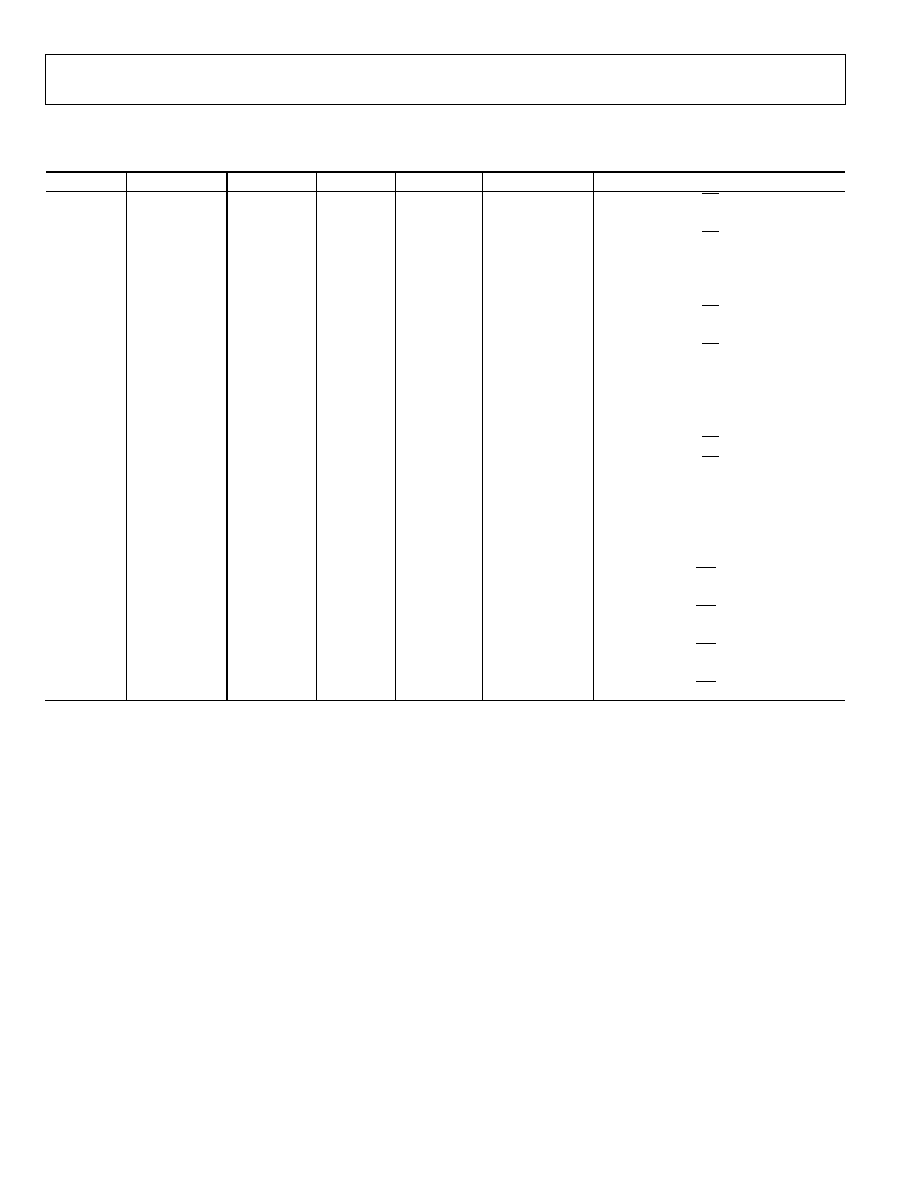
AD5428/AD5440/AD5447
Rev. 0 | Page 26 of 28
OVERVIEW OF AD54xx DEVICES
Table 13.
Part No.
Resolution
No. DACs
INL
(LSB)
Interface Package
Features
AD5424
8
1
Ī0.25
Parallel
RU-16, CP-20
10 MHz BW, 17 ns CS Pulse Width
AD5426
8
1
Ī0.25
Serial
RM-10
10 MHz BW, 50 MHz Serial
AD5428
8
2
Ī0.25
Parallel
RU-20
10 MHz BW, 17 ns CS Pulse Width
AD5429
8
2
Ī0.25
Serial
RU-10
10 MHz BW, 50 MHz Serial
AD5450
8
1
Ī0.25
Serial
RJ-8
10 MHz BW, 50 MHz Serial
AD5432
10
1
Ī0.5
Serial
RM-10
10 MHz BW, 50 MHz Serial
AD5433
10
1
Ī0.5
Parallel
RU-20, CP-20
10 MHz BW, 17 ns CS Pulse Width
AD5439
10
2
Ī0.5
Serial
RU-16
10 MHz BW, 50 MHz Serial
AD5440
10
2
Ī0.5
Parallel
RU-24
10 MHz BW, 17 ns CS Pulse Width
AD5451
10
1
Ī0.25
Serial
RJ-8
10 MHz BW, 50 MHz Serial
AD5443
12
1
Ī1
Serial
RM-10
10 MHz BW, 50 MHz Serial
AD5444
12
1
Ī0.5
Serial
RM-8
10 MHz BW, 50 MHz Serial
AD5415
12
2
Ī1
Serial
RU-24
10 MHz BW, 58 MHz Serial
AD5445 12
2
Ī1
Parallel RU-20,
CP-20 10 MHz BW, 17 ns CS Pulse Width
AD5447
12
2
Ī1
Parallel
RU-24
10 MHz BW, 17 ns CS Pulse Width
AD5449
12
2
Ī1
Serial
RU-16
10 MHz BW, 50 MHz Serial
AD5452
12
1
Ī0.5
Serial
RJ-8, RM-8
10 MHz BW, 50 MHz Serial
AD5446
14
1
Ī1
Serial
RM-8
10 MHz BW, 50 MHz Serial
AD5453
14
1
Ī2
Serial
UJ-8, RM-8
10 MHz BW, 50 MHz Serial
AD5553
14
1
Ī1
Serial
RM-8
4 MHz BW, 50 MHz Serial Clock
AD5556 14
1
Ī1
Parallel RU-28
4 MHz BW, 20 ns WR Pulse Width
AD5555
14
2
Ī1
Serial
RM-8
4 MHz BW, 50 MHz Serial Clock
AD5557 14
2
Ī1
Parallel RU-38
4 MHz BW, 20 ns WR Pulse Width
AD5543
16
1
Ī2
Serial
RM-8
4 MHz BW, 50 MHz Serial Clock
AD5546 16
1
Ī2
Parallel RU-28
4 MHz BW, 20 ns WR Pulse Width
AD5545
16
2
Ī2
Serial
RU-16
4 MHz BW, 50 MHz Serial Clock
AD5547 16
2
Ī2
Parallel RU-38
4 MHz BW, 20 ns WR Pulse Width

AD5428/AD5440/AD5447
Rev. 0 | Page 27 of 28
OUTLINE DIMENSIONS
20
1
11
10
6.40 BSC
4.50
4.40
4.30
PIN 1
6.60
6.50
6.40
SEATING
PLANE
0.15
0.05
0.30
0.19
0.65
BSC
1.20 MAX
0.20
0.09
0.75
0.60
0.45
8į
0į
COMPLIANT TO JEDEC STANDARDS MO-153AC
COPLANARITY
0.10
Figure 49. 20-Lead TSSOP
(RU-20)
Dimensions shown in millimeters
24
13
12
1
6.40 BSC
4.50
4.40
4.30
PIN 1
7.90
7.80
7.70
0.15
0.05
0.30
0.19
0.65
BSC
1.20
MAX
0.20
0.09
0.75
0.60
0.45
8į
0į
SEATING
PLANE
0.10 COPLANARITY
COMPLIANT TO JEDEC STANDARDS MO-153AD
Figure 50. 24-Lead TSSOP
(RU-24)
Dimensions shown in millimeters

AD5428/AD5440/AD5447
Rev. 0 | Page 28 of 28
ORDERING GUIDE
Model
Resolution
INL
(LSBs)
Temperature
Range
Package Description
Package
Option
AD5428YRU
8
Ī0.5
≠40 įC to +125įC
TSSOP (Thin Shrink Small Outline Package)
RU-20
AD5428YRU-REEL
8
Ī0.5
≠40 įC to +125įC
TSSOP (Thin Shrink Small Outline Package)
RU-20
AD5428YRU-REEL7
8
Ī0.5
≠40 įC to +125įC
TSSOP (Thin Shrink Small Outline Package)
RU-20
AD5440YRU
10
Ī0.5
≠40 įC to +125įC
TSSOP (Thin Shrink Small Outline Package)
RU-24
AD5440YRU-REEL
10
Ī0.5
≠40 įC to +125įC
TSSOP (Thin Shrink Small Outline Package)
RU-24
AD5440YRU-REEL7
10
Ī0.5
≠40 įC to +125įC
TSSOP (Thin Shrink Small Outline Package)
RU-24
AD5447YRU
12
Ī1
≠40 įC to +125įC
TSSOP (Thin Shrink Small Outline Package)
RU-24
AD5447YRU-REEL
12
Ī1
≠40 įC to +125įC
TSSOP (Thin Shrink Small Outline Package)
RU-24
AD5447YRU-REEL7
12
Ī1
≠40 įC to +125įC
TSSOP (Thin Shrink Small Outline Package)
RU-24
EVAL-AD5428EB
Evaluation
Kit
EVAL-AD5440EB
Evaluation
Kit
EVAL-AD5447EB
Evaluation
Kit
© 2004 Analog Devices, Inc. All rights reserved. Trademarks and
registered trademarks are the property of their respective owners.
D04462≠0≠7/04(0)



























